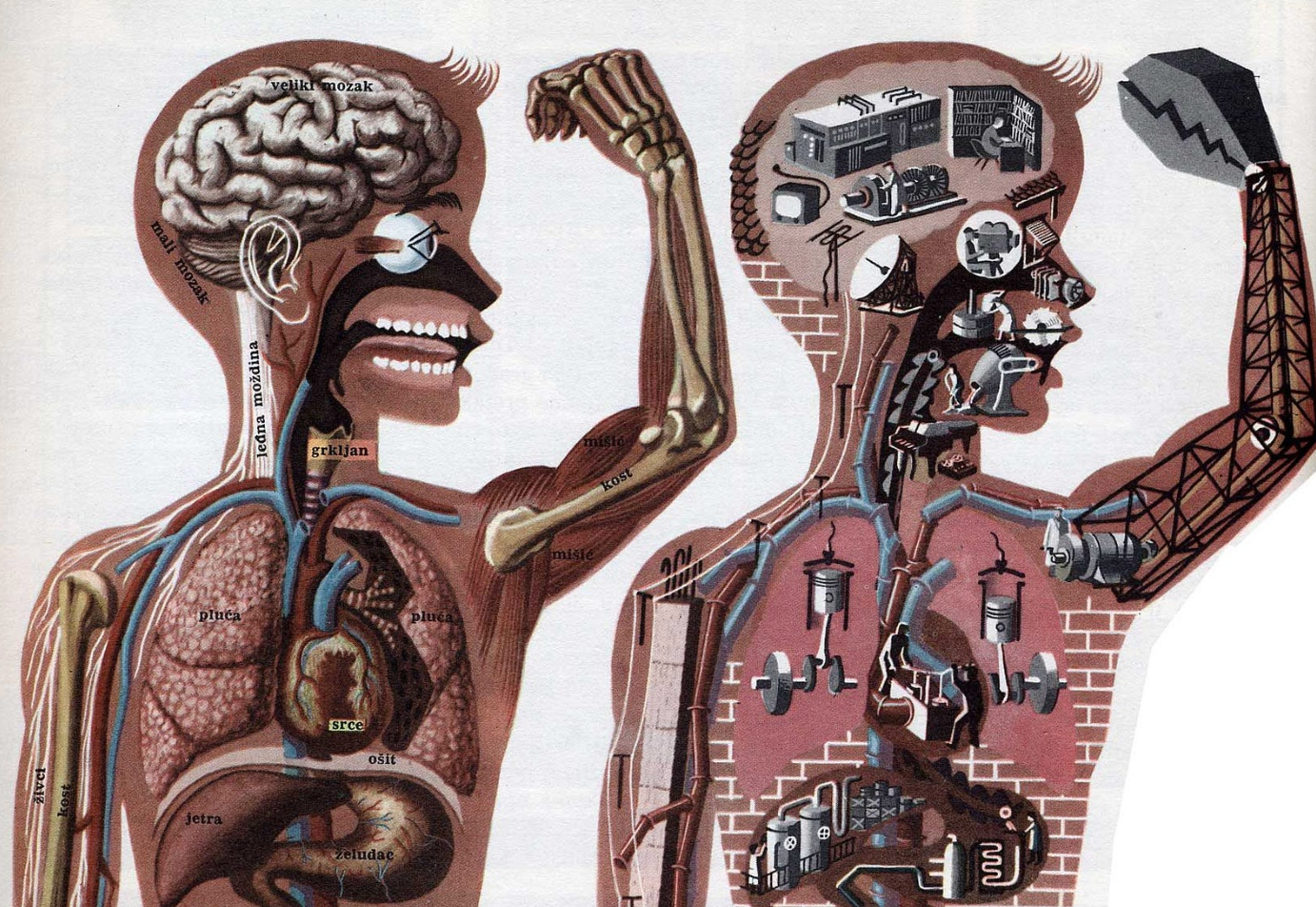
In Chapter 1.1, 1.2, and 1.3, we find a detailed analysis of the three syntheses of the unconscious. At this point, it is evident that Deleuze and Guattari are criticizing the rigidity of psychiatric institutions.
In this section, Deleuze and Guattari are going to highlight their materialist psychiatry which serve as a set of practices in opposition to the psychiatric model.
Note 1: I will constantly be revising this blog post in order to do a line-by-line interpretation of the text.
**Citation Note: Full citation provided at the end of this post
Paragraph One
Deleuze and Guattari begin by reaffirming their earlier thesis concerning delirium:
The famous hypothesis put forward by the psychiatrist G. de Clerambault seems well founded: delirium, which is by nature global and systematic, is a secondary phenomenon, a consequence of partial and local automatistic phenomena. (AO, 22)
They reference French psychiatrist Gatian de Clérambault who considers delirium to be a secondary phenomenon. As noted in Chapter 1.3, for Schreber to declare that he is becoming a woman, he must first internalize the delirium. This process depends on the delirious nature of what defines a woman. Whatever constitutes the concept of a woman — whatever ‘woman’ even means — must exist prior to the delirium in the form of affections upon Schreber’s body without organs.
Although the concept of woman is portrayed as a delirious notion above, it’s important to recognize that this is a form of collective delirium (i.e., the category of woman is a social construction). While Deleuze and Guattari don’t elaborate much on the broader implications of delirium in this passage, one can draw from Deleuze’s works Empiricism and Subjectivity and Two Regimes of Madness to assert that delirium is essentially imagination itself. In other words, delirium is a secondary phenomenon that does not strictly adhere to a linear path of recording; instead, delirium diverges from the path of recording. If this divergence becomes significant enough to create a bifurcation, it is referred to as schizophrenia.
For the sake of clarity, let’s briefly discuss schizophrenia. In Anti-Oedipus, schizophrenia is understood in two distinct ways. First, there is schizophrenia as a clinical condition, which is highlighted in the sixth paragraph of this section. In this case, schizophrenia is interrupted or put into the context of an end goal; these are the people found in mental institutions. Second, there is schizophrenia as the process of production. Capitalism produces this schizophrenic subject as the result of decoded and deterritorialized flows of desire, which is highlighted in the final few paragraphs of this section. In the first case — the case of the clinical entity — schizophrenia as a process of decoding and deterritorialization becomes interrupted or turned into an end goal where schizophrenia is divorced from its processual nature. In the second case, schizophrenia serves as a process in a state of becoming. Regardless, delirium is especially important in the context of all cases of schizophrenia because it represents a departure from an established path of recording. The difference between schizophrenia as a clinical condition and schizophrenia as a process of decoding and deterritorialization lies in the degree to which this delirium manifests.
Deleuze and Guattari continue:
Delirium is in fact characteristic of the recording that is made of the process of production of the desiring-machines; and though there are syntheses and disorders (affections) that are peculiar to this recording process, as we see in paranoia and even in the paranoid forms of schizophrenia, it does not constitute an autonomous sphere, for it depends on the functioning and the breakdowns of desiring-machines. (AO, 22)
To clarify, Deleuze and Guattari are reiterating their earlier claim that nothing is independent of the production process, specifically the production of recording. They argue that there are specific affections — or particular ways the body experiences certain phenomena — that can appear atypical within this recording process. For example, Deleuze and Guattari reference paranoid forms of schizophrenia, such as a paranoid schizophrenic believing that someone intends to harm them, even if no such threat exists. However, it’s important to emphasize that these beliefs, thoughts, or affections do not exist in isolation; they are not part of an autonomous sphere. Paranoid schizophrenia and the deliriums associated with it are secondary to the recording process itself. It is contingent upon the functioning and breakdown of desiring-machines, meaning that all these phenomena are interconnected and dependent upon the process of production.

Regardless, Deleuze and Guattari continue by examining Clerambault’s arguments pertaining to delirium:
Nonetheless Clerambault used the term “(mental) automatism” to designate only athematic phenomena — echolalia, the uttering of odd sounds, or sudden irrational outbursts — which he attributed to the mechanical effects of infections or intoxications. (AO, 22)
Clerambault’s utilization of the term ‘(mental) automatism’ to describe athematic phenomena reflects his belief that behaviors considered nonsensical, such as the repetition of words, the utterance of strange sounds, or ‘irrational outbursts,’ are akin to mechanical effects, similar to those resulting from infections or intoxications (e.g., diseases, drugs, alcohol, etc.). In this manner, Clerambault finds these behaviors to be isolated incidents rather than a secondary result of the functioning and breakdown of desiring-machines.
Deleuze and Guattari summarize Clerambault’s main argument succinctly:
Moreover, [Clerambault] explained a large part of delirium in turn as an effect of automatism; as for the rest of it, the “personal” part, in his view it was of the nature of a reaction and had to do with “character,” the manifestations of which might well precede the automatism (as in the paranoiac character, for instance). (AO, 22)
Deleuze and Guattari are referring to Clerambault’s writings found in Oeuvre psychiatrique, which were first published in 1942 (and later fully published posthumously in 1981). In these texts, Clerambault identifies two key aspects of delirium. First, he views delirium as resulting from automatism, suggesting that certain responses or behaviors are automatic and caused by physical conditions like infections or intoxications. Second, he posits that the remaining aspects of delirium are linked to an individual’s character, why may influence of precede these automatic responses.
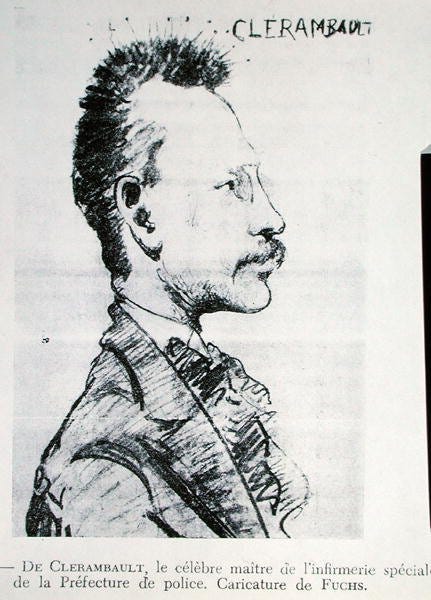
So … what’s the difference between Clerambault’s perspective on delirium and that of Deleuze and Guattari? Deleuze and Guattari write:
Hence Clerambault regarded automatism as merely a neurological mechanism in the most general sense of the word, rather than a process of economic production involving desiring-machines.
(AO, 22; emphasis mine)
Evidently, Deleuze and Guattari criticize Clerambault’s approach to history in relation to his psychiatric theories:
As for history, [Clerambault] was content merely to mention its innate or acquired nature. (AO, 22)
Clerambault’s brief mention of history is insufficient for Dleuze and Guattari. Clerambault considers history to be either innate (inherent from birth), acquired (shaped by one’s character), or a combination of both. However, Deleuze and Guattari critique this view for being overly reductive. Clerambault emphasizes automatism and treats experiences as isolated rather than part and parcel with the sociohistorical field.
Unfortunately for Clerambault, Deleuze and Guattari regard him similarly to how Karl Marx regarded the German philosopher Ludwig Feuerbach:
Clerambault is the Feuerbach of psychiatry, in the sense in which Marx remarks: “Whenever Feuerbach looks at things as a materialist, there is no history in his works, and whenever he takes history into account, he no longer is a materialist.” (AO, 22; emphasis mine)
In this quote, Deleuze and Guattari are directly referencing Marx’s Theses on Feuerbach, written in 1845 and published in 1888. Although Marx acknowledged some of Feuerbach’s insights as noteworthy — particularly Feuerbach’s focus on material conditions — he criticized Feuerbach for being overly reductive. Marx found Feuerbach’s analysis to lack consideration of how these material conditions are shaped by historical and social relations. Deleuze and Guattari employ Marx’s criticisms of Feuerbach in order to draw a parallel to Clerambault; as they state, “Clerambault is the Feuerbach of psychiatry.”

As Clerambault’s psychiatry lacked a conceptualization of the sociohistorical, Deleuze and Guattari posit was a true materialist psychiatry looks like:
A truly materialist psychiatry can be defined, on the contrary, by the twofold task it sets itself: introducing desire into the mechanism, and introducing production into desire. (AO, 22)
We will soon learn the extent of what Deleuze and Guattari’s materialist psychiatry has to offer, but we must continue.
Paragraph Two
At any rate, Deleuze and Guattari continue by calling out false forms of materialism for what it is:
There is no very great difference between false materialism and typical forms of idealism. (AO, 22; emphasis mine)
To reach this conclusion, Deleuze and Guattari examine how schizophrenia has been formally theorized and how it has been confined within a simplistic, reductive trinary framework. They argue that the normative understanding of schizophrenia has manifested itself as a false materialism, which ultimately resembles a conventional form of idealism, detached from the material realities that produce it. Deleuze and Guattari write:
The theory of schizophrenia is formulated in terms of three concepts that constitute its trinary schema: dissociation (Kraepelin), autism (Bleuler), and space-time or being-in-the-world (Binswanger). (AO, 22)
Let’s review each of these concepts and thinkers associated with them:
Dissociation (Kraepelin)
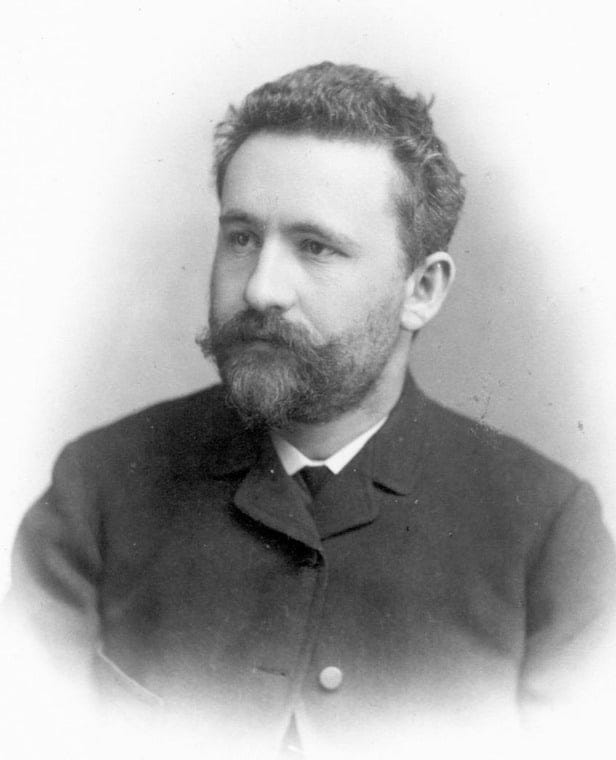
German psychiatrist, Emil Kraepelin, was a pioneering figure in the classification of mental illnesses. He introduced the concept of “dementia praecox,” an early classification that later evolved into the modern understanding of schizophrenia. Kraepelin’s classification system distinguished between different forms of psychosis, including manic-depression (now known as bipolar disorder) and dementia praecox. Although Kraepelin did not use the term “schizophrenia” (which was introduced later by Eugen Bleuler, whom we will get to shortly), his work laid the foundation for modern psychiatric classification.
Following the quote above — Deleuze and Guattari write:
[Kraepelin’s concept] is an explanatory concept that supposedly locates the specific dysfunction or primary deficiency. (AO, 22)
Essentially, Kraepelin introduced the concept of dissociation to explain dementia praecox, proposing that the disorder was rooted in a specific dysfunction or deficiency, which he largely understood to be a biological impairment.
Autism (Bleuler)
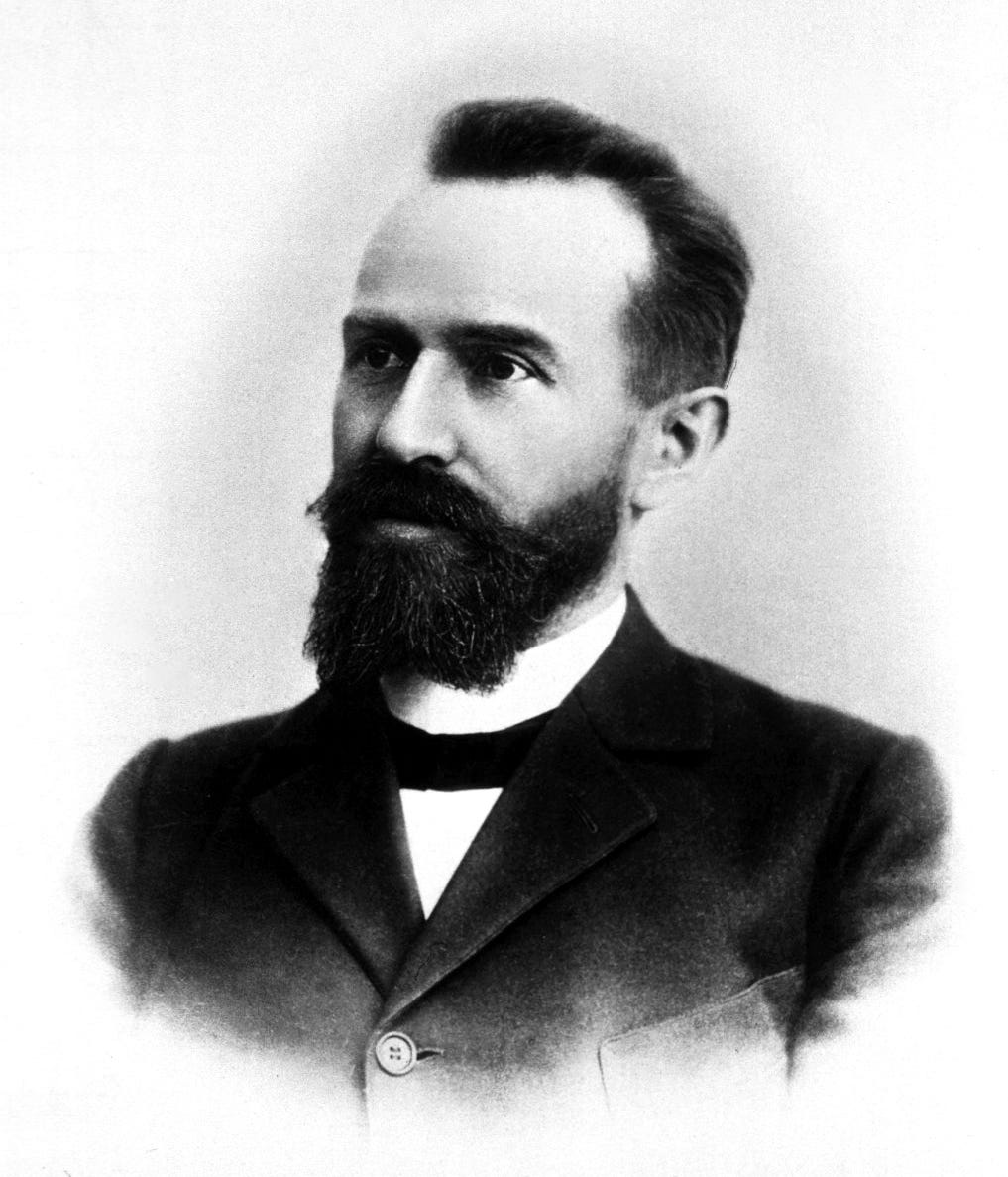
Swiss psychiatrist, Eugen Bleuler, introduced the term “schizophrenia” to replace “demential praecox,” critiquing Kraepelin’s concept for its narrow focus. Kraepelin viewed dementia praecox as a progressive disorder that inevitably worsened over time. In contrast, Bleuler offered a broader perspective, acknowledging degrees of impairment and recognizing a wider range of behaviors. He introduced the concept of “autism” as a symptom of schizophrenia, which, in his usage, referred to a literal, etymological sense of the word: autism as being closed off or detached from reality. To be clear, this is much different from contemporary understandings of autism.
Deleuze and Guattari state:
[Bleuler’s concept] is an ideational concept indicating the specific nature of the effect of the disorder: the delirium itself or the complete withdrawal from the outside world, “the detachment from reality, accompanied by a relative or an absolute predominance of [the schizophrenic’s] inner life.” (AO, 22–23)
The sentenced cited by Deleuze and Guattari above (though not cited in Anti-Oedipus) derives from Bleuler’s work Dementia Praecox or the Group of Schizophrenias, published in 1911. Bleuler’s perspective on schizophrenia emphasizes the notion of individuals being closed off from the outside world or detached from reality. While there may be variations in how this detachment manifests in each individual, Bleuler consistently views this detachment from reality as a core feature of the disorder.
Space-time or being-in-the-world (Binswanger)
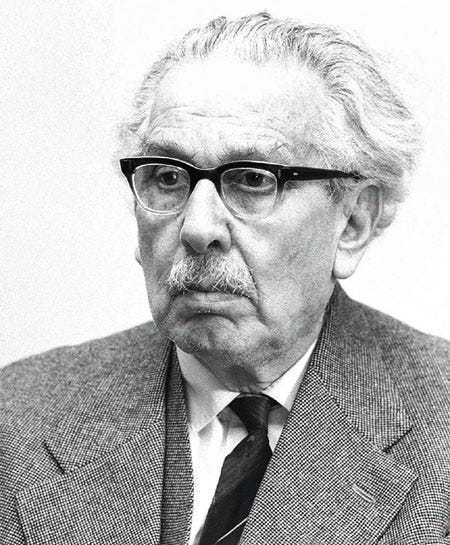
Swiss psychiatrist, Ludwig Binswanger, was concerned with how individuals with schizophrenia interacted with and perceived their environment. Binswanger is recognized as a key figure in existential psychology, a field that emphasizes an individual’s personal relationship with their surroundings and their subjective experience of reality. His seminal work, Being-in-the-world, published in 1963, explores and describes how schizophrenics relate to spatial and temporal dimensions.
Deleuze and Guattari explain:
[Binswanger’s] concept is a descriptive one, discovering or rediscovering the delirious person in his own specific world. (AO, 23)
Rather than providing an explanatory reason for schizophrenia, Binswanger was concerned with the lived experience of schizophrenia.
What is common between these three concepts and thinkers?
Though Kraepelin, Bleuler, and Binswanger differ in how they conceptualize schizophrenia, they all have one thing in common: the ego.
Deleuze and Guattari state their overarching criticism of these thinkers:
What is common to these three concepts is the fact that they all relate the problem of schizophrenia to the ego through the intermediary of the “body image” — the final avatar of the soul, a vague conjoining of the requirements of spiritualism and positivism. (AO, 23)
These theorists fall short by conceptualizing schizophrenia solely as an individual pathology. Deleuze and Guattari’s critique focuses on the assumption that a coherent self exists beneath schizophrenia and that this self can be discovered by overcoming the disorder. They argue that schizophrenia should be understood in the context of sociohistorical conditions, rather than through an idealized concept of the body and its expected functions.
Paragraph Three
Deleuze and Guattari assert that the schizo fails to believe in the ego:
The ego, however, is like daddy-mommy: the schizo has long since ceased to believe in it. [The schizo] is somewhere else, beyond or behind or below these problems, rather than immersed in them. (AO, 23)
However, this is not to imply that the schizo does not face their own set of challenges. Deleuze and Guattari emphasize this point while questioning the peculiar and persistent urge to make the schizo conform to the very problems they have managed to avoid. Why insist on making the schizo confront the issues of mommy and daddy when they have already escaped the issues of mommy and daddy? They write:
And wherever [the schizo] is, there are problems, insurmountable sufferings, unbearable needs. But why try to bring [the schizo] back to what [the schizo] has escaped from, why set [the schizo] back down amid problems that are no longer problems to [the schizo], why mock his truth by believing that we have paid it its due by merely figuratively taking our hats off to it? (AO, 23)
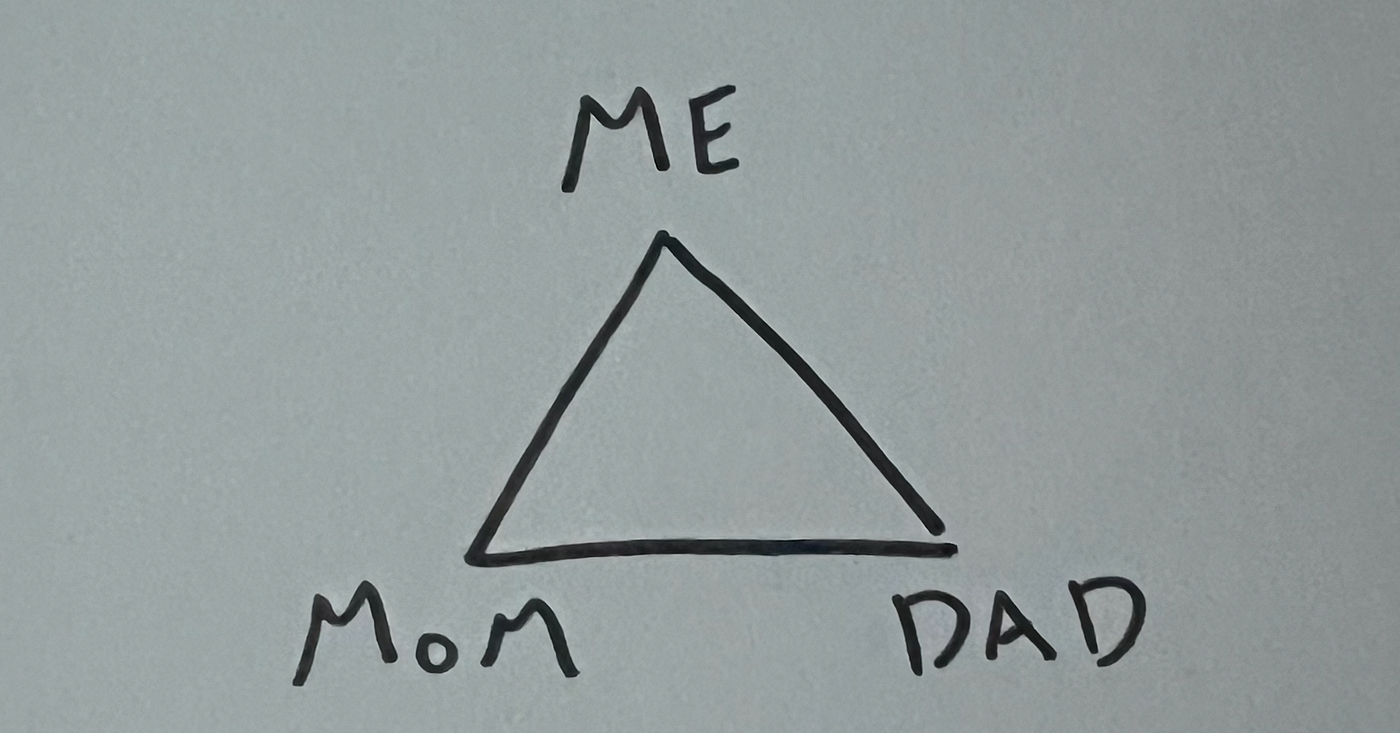
As stated in the second paragraph of Chapter 1.4, psychoanalysts are concerned “relat[ing] the problem of schizophrenia to the ego through the intermediary of the ‘body image’” (AO, 23). Deleuze and Guattari respond to this from the perspective of the schizo:
There are those who will maintain that the schizo is incapable of uttering the word I, and that we must restore his ability to pronounce this hallowed word. All of which the schizo sums up by saying: they’re fucking me over again. (AO, 23)
Regarding the schizo being marginalized (or rather, the schizo being ‘fucked over’), Deleuze and Guattari refer to Irish novelist Samuel Beckett’s 1953 novel, The Unnamable:
“I won’t say I any more, I’ll never utter the word again; it’s just too damn stupid. Every time I hear it, I’ll use the third person instead, if I happen to remember to. If it amuses them. And it won’t make one bit of difference.” (AO, 23)
Thus, although the the schizo says “I”, this “I” is fundamentally divorced from the Cartesian “I”:
And if [the schizo] does chance to utter the word I again, that won’t make any difference either. [The schizo] is too far removed from these problems, too far past them. (AO, 23)
Paragraph Four
As the book’s title suggests, Anti-Oedipus seeks to deconstruct Sigmund Freud’s Oedipus complex which reduces the ego to these limited perspectives. Deleuze and Guattari write:
Even Freud never went beyond this narrow and limited conception of the ego. (AO, 23)
It’s not that Freud lacked the ability to go beyond this limited conception of the ego; rather, his own propagation of the Oedipus complex restricted him from from moving beyond this limited conception of the ego:
And what prevented him from doing so was his own tripartite formula — the Oedipal, neurotic one: daddy-mommy-me. (AO, 23)
By restricting desire to the rigid framework of daddy-mommy-me, Freud was unable to envision desire outside of this structure. Furthermore, we might as well question the relationship Freud’s Oedipus complex has to the erroneous conceptualization of autism and schizophrenia theorized by Kraepelin and Bleuler:
We may well ponder the possibility that the analytic imperialism of the Oedipus complex led Freud to rediscover, and to lend all the weight of his authority to, the unfortunate misapplication of the concept of autism to schizophrenia. (AO, 23)
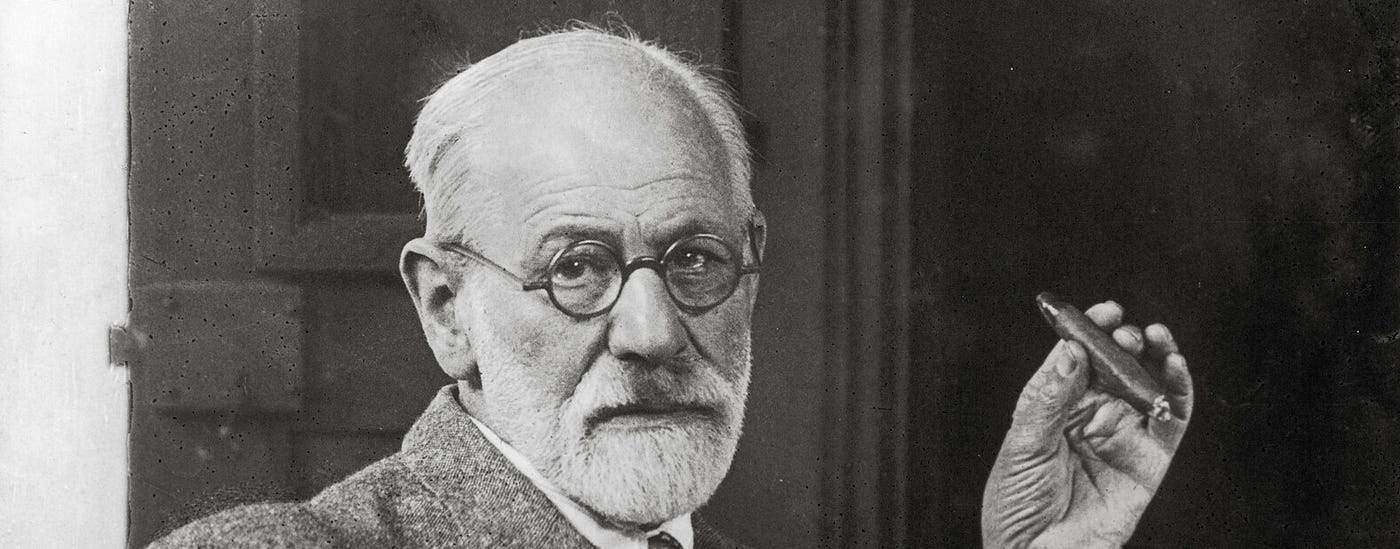
Regardless, Deleuze and Guattari make clear that Freud’s project polices schizophrenia:
For we must not delude ourselves: Freud doesn’t like schizophrenics. He doesn’t like their resistance to being oedipalized, and tends to treat them more or less as animals. (AO, 23; emphasis mine)
Freud’s harsh treatment of schizophrenics stems from his belief in a normative subject capable of achieving transference. Anyone who falls outside of this established norm is subject to punishment:
They mistake words for things, he says. They are apathetic, narcissistic, cut off from reality, incapable of achieving transference; they resemble philosophers — “an undesirable resemblance.”
(AO, 23; emphasis mine)
Before analyzing this quote, it’s important to examine the two references to Freud.
- First, when Deleuze and Guattari note that Freud claims thee schizophrenic “mistake[s] words for things,” they are drawing from Freud’s The Unconscious, an essay published in 1915. Freud writes:
If we ask ourselves what it is that gives the character of strangeness to the substitutive formation and the symptom in schizophrenia, we eventually come to realize that it is the predominance of what has to do with words over what has to do with things. (The Unconscious; emphasis mine)
- Second, the phrase “an undesirable resemblance” is an unattributed citation; however, like the previous reference, it refers to Freud’s essay The Unconscious, where he states:
When we think in abstractions there is a danger that we may neglect the relations of words to unconscious thing-presentations, and it must be confessed that the expression and content of our philosophizing then begins to acquire an unwelcome resemblance to the mode of operation of schizophrenics. (The Unconscious; emphasis mine)
Now, let us get back to Anti-Oedipus:
In the previous quote from Anti-Oedipus, Deleuze and Guattari explain how Freud identifies a commonality between schizophrenics and philosophers, noting an “undesirable resemblance” between them, likening them to animals. This is because Freud views the schizophrenic as incapable of transference. In psychoanalytic theory, transference refers to the process by which an analysand redirects their unconscious childhood feelings and desires onto a new object, typically the therapist or psychoanalyst.
But why is transference necessary for normative subjectivity in the first place?
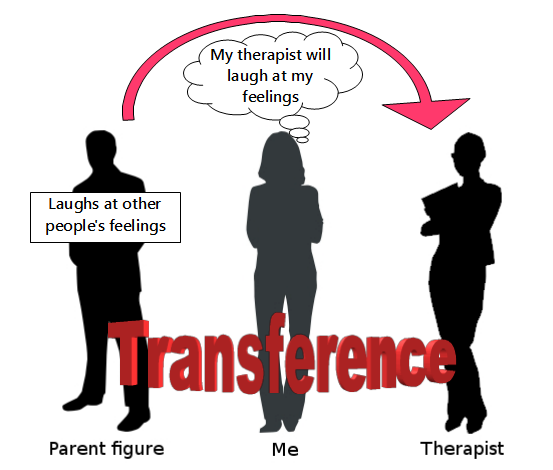
Paragraph Five
Deleuze and Guattari continue by addressing the analytical challenge in psychoanalysis:
The question as to how to deal analytically with the relationship between drives (pulsions) and symptoms, between the symbol and what is symbolized, has arisen again and again. (AO, 23)
On this point, they posit a few rhetorical questions:
Is this relationship to be considered causal? Or is it a relationship of comprehension? A mode of expression? (AO, 23–24)
However, we must first consider whether the initial question about how we analytically approach the relationship between drives and symptoms is even a valid starting point. Deleuze and Guattari find this analytical challenge in psychoanalysis to be too reductive:
The question, however, has been posed too theoretically. The fact is, from the moment that we are placed within the framework of Oedipus — from the moment that we are measured in terms of Oedipus — the cards are stacked against us, and the only real relationship, that of production, has been done away with. (AO, 24)
A well-known saying attributed to psychologist Abraham Maslow is relevant to this discussion: “If the only tool you have is a hammer, it is tempting to treat everything as if it were a nail.”
When forced within the confines of Oedipus, we have already lost.
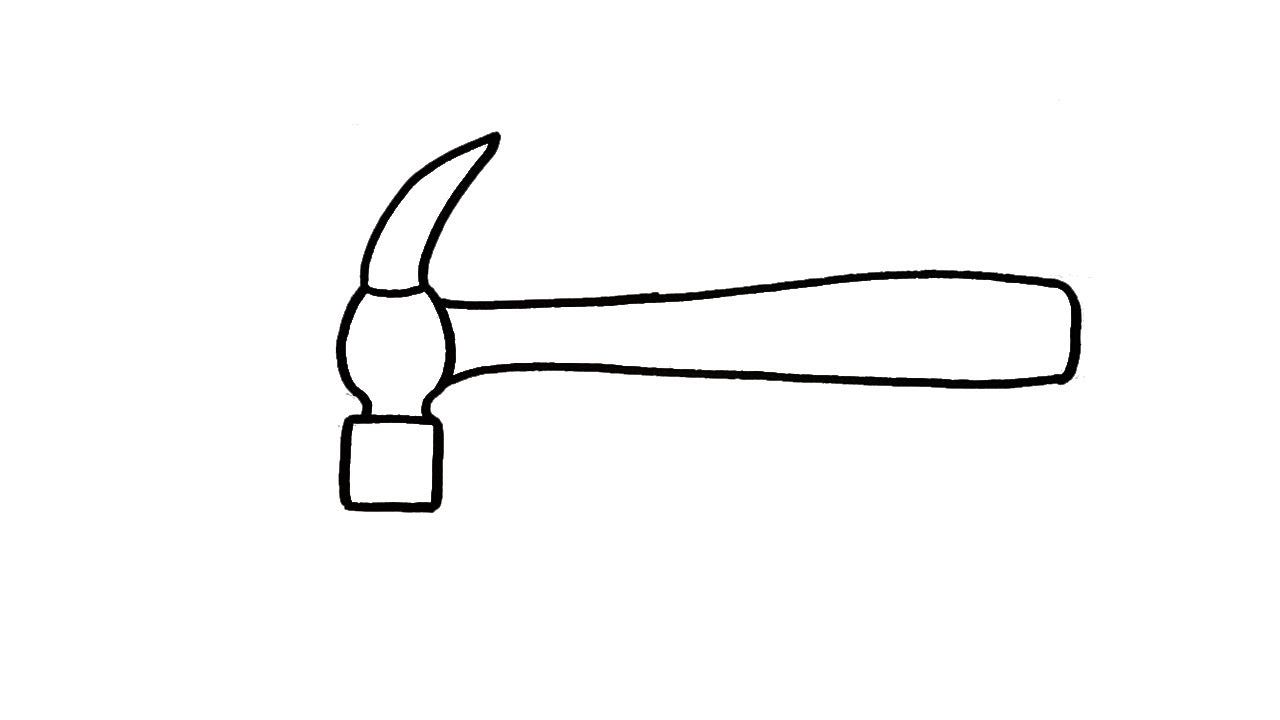
This is not to suggest that psychoanalysis has made no significant discoveries. In fact, Deleuze and Guattari acknowledge that psychoanalysis disovered the existence of the unconscious:
The great discovery of psychoanalysis was that of the production of desire, of the productions of the unconscious. (AO, 24)
Yet, with the terrifying presence of Oedipus, this discovery becomes lost within a series of symbols, all pertaining to parental figures:
But once Oedipus entered the picture, this discovery was soon buried beneath a new brand of idealism: a classical theater was substituted for the unconscious as a factory; representation was substituted for the units of production of the unconscious; and an unconscious that was capable of nothing but expressing itself — in myth, tragedy, dreams — was substituted for the productive unconscious. (AO, 24)
One of my favorite lines in the book is: “a classical theater was substituted for the unconscious as a factory.” In this passage, Deleuze and Guattari argue that Oedipus functions merely as a system of representations, reducing the unconscious to a theater with Oedipus is on stage.
- You want to read a blog post? Well, that’s just because you want to kill your father and have sexual relations with your mother.
- You want to write a blog post? Well, that’s just because you want to kill your father and have sexual relations with your mother.
Everything within Freudian psychoanalysis is reduced to Oedipus. Everything is constantly interpreted and examined. Instead, we ought to conceptualize the unconscious as a factory rather than substituting it with a classical theater with myth, tragedy, or dreams on stage.

Paragraph Six
So … why is explaining schizophrenia in relation to the ego problematic? Deleuze and Guattari state:
Every time that the problem of schizophrenia is explained in terms of the ego, all we can do is “sample” a supposed essence or a presumed specific nature of the schizo, regardless of whether we do so with love and pity or disgustedly spit out the mouthful we have tasted. (AO, 24)
Here, Deleuze and Guattari argue that when one attempts to understand schizophrenia through the lens of the ego, one mistakenly assumes an inherent nature or “supposed essence” of the schizo. Whether we are empathetic or disdainful towards the schizophrenic, the approach of understanding schizophrenia through the ego is inherently problematic. In this case, Deleuze and Guattari restate the ways in which the schizophrenic has been “sampled” by Kraepelin, Bleuler, and Binswanger:
We have “sampled” him once as a dissociated ego [Kraepelin’s dementia praecox], another time as an ego cut off from the world [Bleuler’s autism], and yet again — most temptingly — as an ego that had not ceased to be, who was there in the most specific way, but in his very own world, though he might reveal himself to a clever psychiatrist, a sympathetic superobserver — in short, a phenomenologist [Binswanger’s subjective experience].
(AO, 24; emphasis mine)
- It’s noteworthy that Deleuze and Guattari highlight Binswanger’s analysis of the schizophrenic as a phenomenologist, suggesting that the only aspect that should be understood is the schizophrenic’s direct spatiotemporal experience with the world.
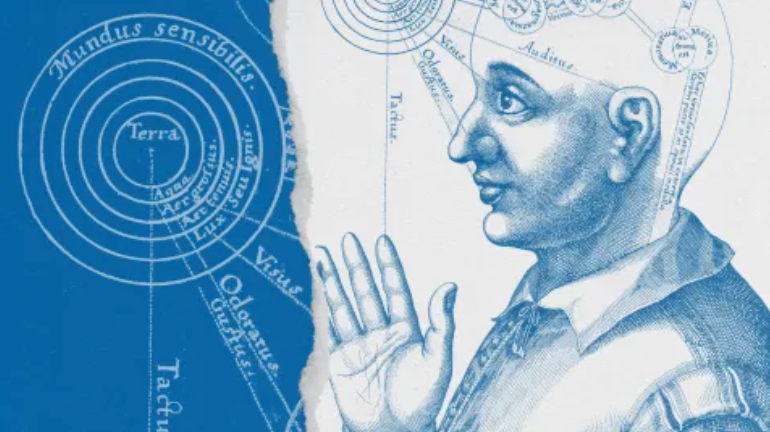
Deleuze and Guattari continue by referring to Marx (this is another one of my favorite lines from the text):
Let us remember once again one of Marx’s caveats: we cannot tell from the mere taste of wheat who grew it; the product gives us no hint as to the system and the relations of production. (AO, 24)
This reference to Marx originates from his seminal work Das Kapital, specifically, Part I, The Commodity. In this section, Marx writes:
From the taste of wheat it is not possible to tell who produced it, a Russian serf, a French peasant or an English capitalist.
(Das Kapital; emphasis mine)
Deleuze and Guattari argue that analyzing schizophrenia solely through the lens of the ego offers a limited perspective, hindering our ability to understand how both the schizophrenic and their associated symptoms are produced. Just as tasting wheat doesn’t reveal who grew it or the broader agricultural system behind it, focusing solely on the ego fails to uncover the deeper processes and social relations that contribute to the development of schizophrenia and its associated symptoms.
Thus, when a theoretician attempts to conceptualize schizophrenia through localized and abstract framework (such as those of Kraepelin, Blueler, and Binswanger), they fail to grasp the actual processes that produce the condition. Deleuze and Guattari write:
The product appears to be all the more specific, incredibly specific and readily describable, the more closely the theoretician relates it to ideal forms of causation, comprehension, or expression, rather than to the real process of production on which it depends. (AO, 24)
Yet, upon the examination and interrogation of the schizophrenic through localized and abstract methods, the schizophrenic appears as a clearly defined entity:
The schizophrenic appears all the more specific and recognizable as a distinct personality if the process is halted, or if it is made an end and a goal in itself, or if it is allowed to go on and on endlessly in a void, so as to provoke that “horror of . . . extremity wherein the soul and body ultimately perish” (the autist). Kraepelin’s celebrated terminal state. . .
(AO, 24)
Here, Deleuze and Guattari describe the schizophrenic as a clinical entity shaped by institutional practices. However, they do not confine their definition of the schizophrenic to just this clinical perspective. Instead, they argue that the schizophrenic is easily identified as a “distinct personality” through institutional, localized, and abstract methods employed to examine the schizophrenic. At any rate, common understandings of schizophrenia are rooted in clinical methods, which often involve the attempt to halt the process of production or turn the process of production into an end goal — such as policing the schizophrenic and forcing conformity. The schizophrenic one finds in mental institutions is a clinical entity; Deleuze and Guattari make a clear distinction between the schizophrenic as a clinical entity and the schizophrenic as a subject traversing the body without organs, aligning with nature as a process of production.
In the quote above, Deleuze and Guattari reference a passage from Aaron’s Rod by the prominent English novelist D.H. Lawrence to illustrate Kraepelin’s categorization of dementia praecox. Kraepelin’s approach (which views schizophrenia as a purely degenerative and worsening condition)— along with the attempts to halt the process of production or turn the process into an end goal — only continues to produce the symptoms that psychoanalysts aim to address.
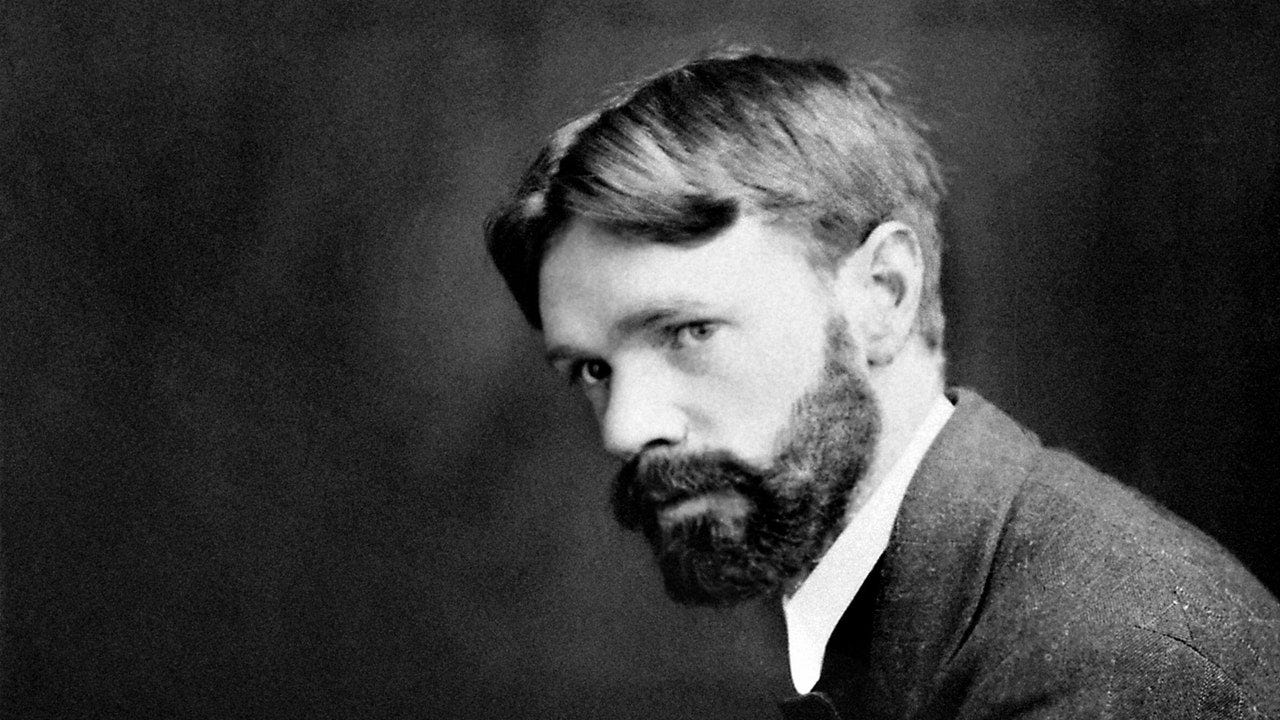
However, what happens when we describe the schizophrenic through the material process of production? Deleuze and Guattari argue:
But the moment that one describes, on the contrary, the material process of production, the specificity of the product tends to evaporate, while at the same time the possibility of another outcome, another end result of the process appears. (AO, 24)
Earlier, we criticized abstract approaches to explaining schizophrenia as overly reductive, likening them to being unable to determine who grew wheat just by tasting it. Similarly, Deleuze and Guattari argue that defining schizophrenia through the material process of production —i.e., by examining the processes by which the condition developed, much like analyzing how wheat grew and who cultivated it — leads to a similar oversimplification. By concentrating on the material processes and who was involved, we risk homogenizing every grain of wheat from a field, reducing its essence to merely who grew it. In both cases — whether through an abstract method or a material process— we fall short in defining schizophrenia.
To put simply, Feurbach is the Clearambault of materialism.
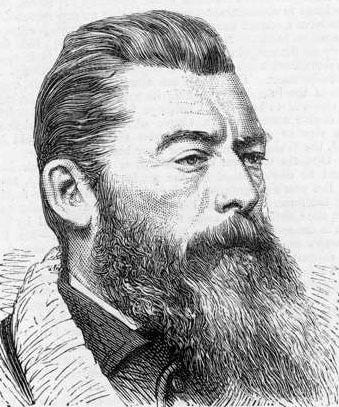
Prior to the production of the schizophrenic as a clinical entity, it’s essential not to overlook what lies beneath it all (or rather, what schizophrenia is at the level of desiring-production). Deleuze and Guattari write:
Before being a mental state of the schizophrenic who has made himself into an artificial person through autism, schizophrenia is the process of the production of desire and desiring-machines.
(AO, 24; emphasis mine)
At this juncture, Deleuze and Guattari raise the question of how schizophrenia, as a process of production and desiring-machines, transitions to the schizophrenic as a clinical entity:
How does one get from one to the other, and is this transition inevitable? This remains the crucial question. (AO, 24)
To answer this question, Deleuze and Guattari point to the insights of German-Swiss psychiatrist and philosopher Karl Jaspers:
Karl Jaspers has given us precious insights, on this point as on so many others, because his “idealism” was remarkably atypical. (AO, 24–25)
Now, let’s move on to describe Jasper’s atypical idealism.
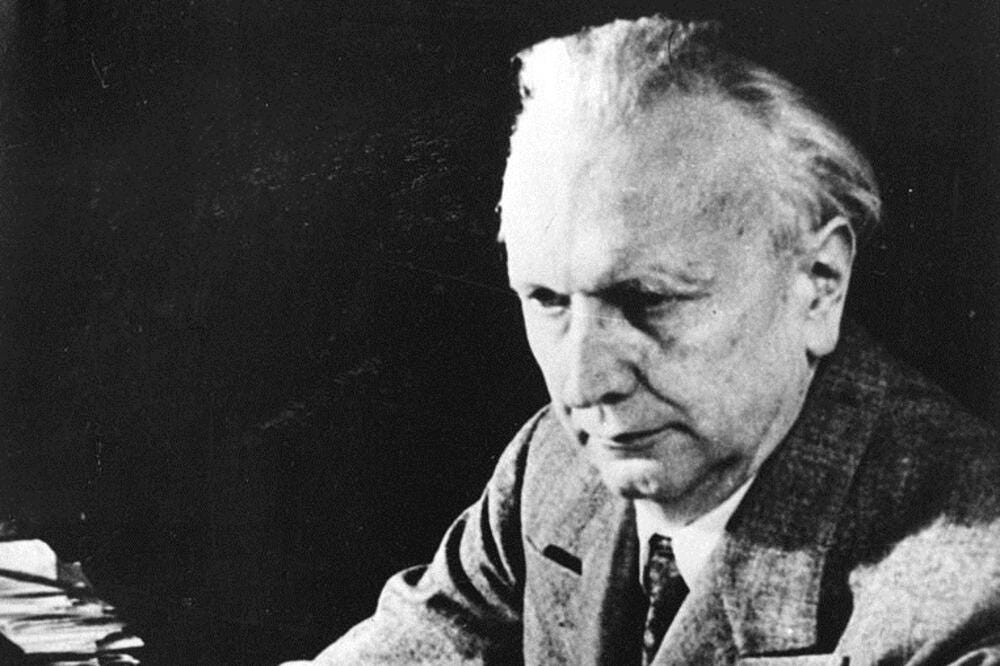
Deleuze and Guattari examine how Jaspers diverges from conventional approaches to understanding and conceptualizing schizophrenia:
Contrasting the concept of process with those of reaction formation or development of the personality, he views process as a rupture or intrusion, having nothing to do with an imaginary relationship with the ego; rather, it is a relationship with the “demoniacal” in nature. (AO, 25)
Rather than framing schizophrenia in terms of and “reaction formation” or personality development, Jaspers finds schizophrenia to be like that of a rupture in the ongoing process of psychological development — a sudden disruption from normative processes.
Yet, Jaspers falls short:
The one thing Jaspers failed to do was to view process as material economic reality, as the process of production wherein Nature = Industry, Nature = History. (AO, 25)
By not relating schizophrenia to material economic realities, Jaspers unfortunately falls short in explaining schizophrenia. Deleuze and Guattari argue that a comprehensive understanding of schizophrenia requires connecting this rupture to broader sociohistorical processes.
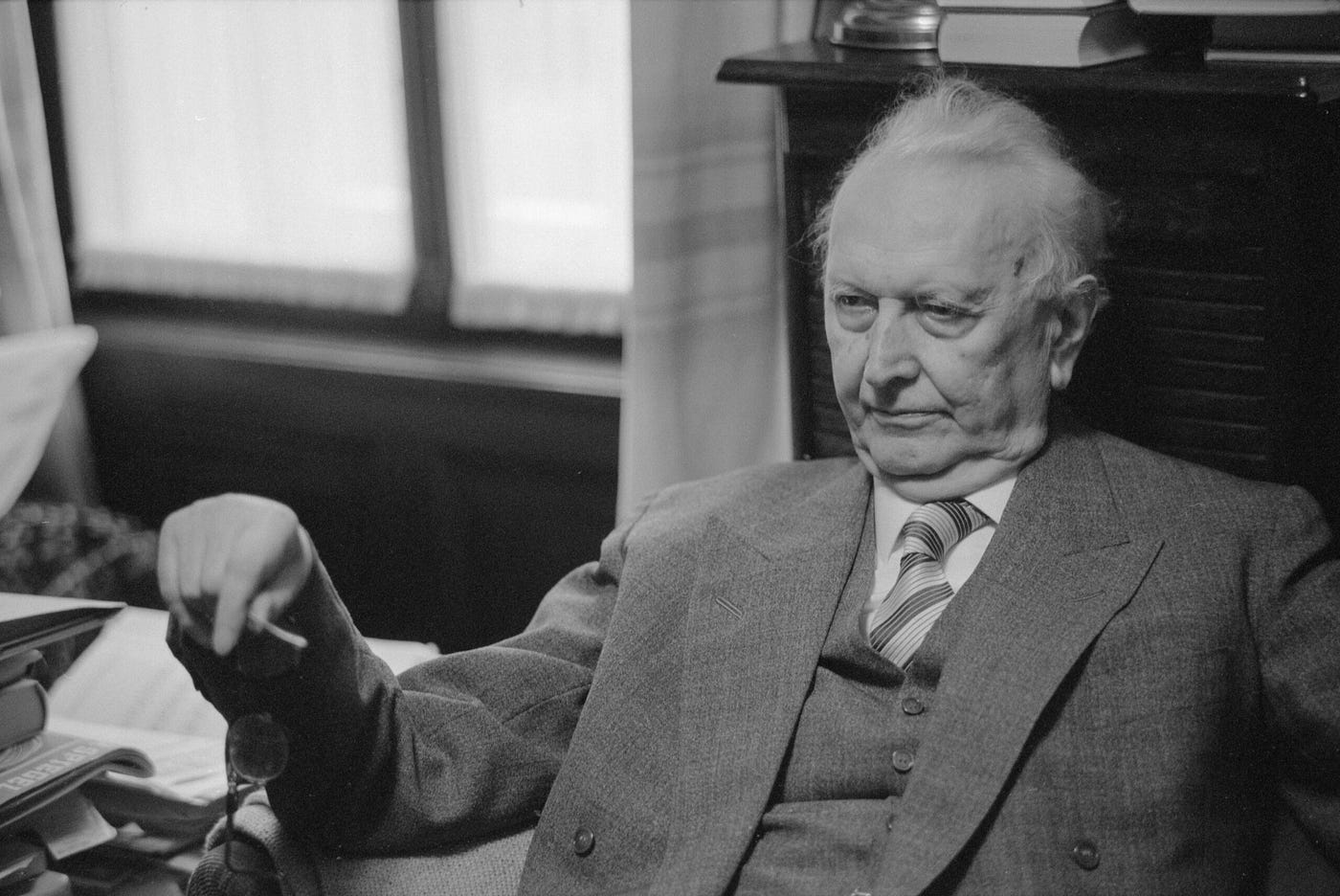
Paragraph Seven
Deleuze and Guattari begin the seventh paragraph by discussing the logic of desire:
To a certain degree, the traditional logic of desire is all wrong from the very outset: from the very first step that the Platonic logic of desire forces us to take, making us choose between production and acquisition.
(AO, 25; emphasis mine)
From the earliest forms of Western philosophy, the understanding of desire has often been framed in terms of deficiency or lack. For the Ancient Greek philosopher, Plato, desire is viewed as yearning for what one is lacking (i.e., I desire something because I do not have it). A central aspect of Plato’s philosophy is his Theory of Forms. According to this theory, there exists a realm beyond the material world that is constituted by perfect, unchanging Forms or Ideas. These Forms represent the true essence of all things. In Plato’s view, the material world is merely a shadow of these ideal Forms which is best exemplified by Plato’s Allegory of the Cave (Book VII of Plato’s Republic).
For Plato, the philosopher’s goal is to seek knowledge of these Forms through contemplation. Thus, in a Platonist sense, desire is fundamentally understood as attaining what one lacks, specifically the perfect knowledge of the Forms that exists beyond the imperfect material world.
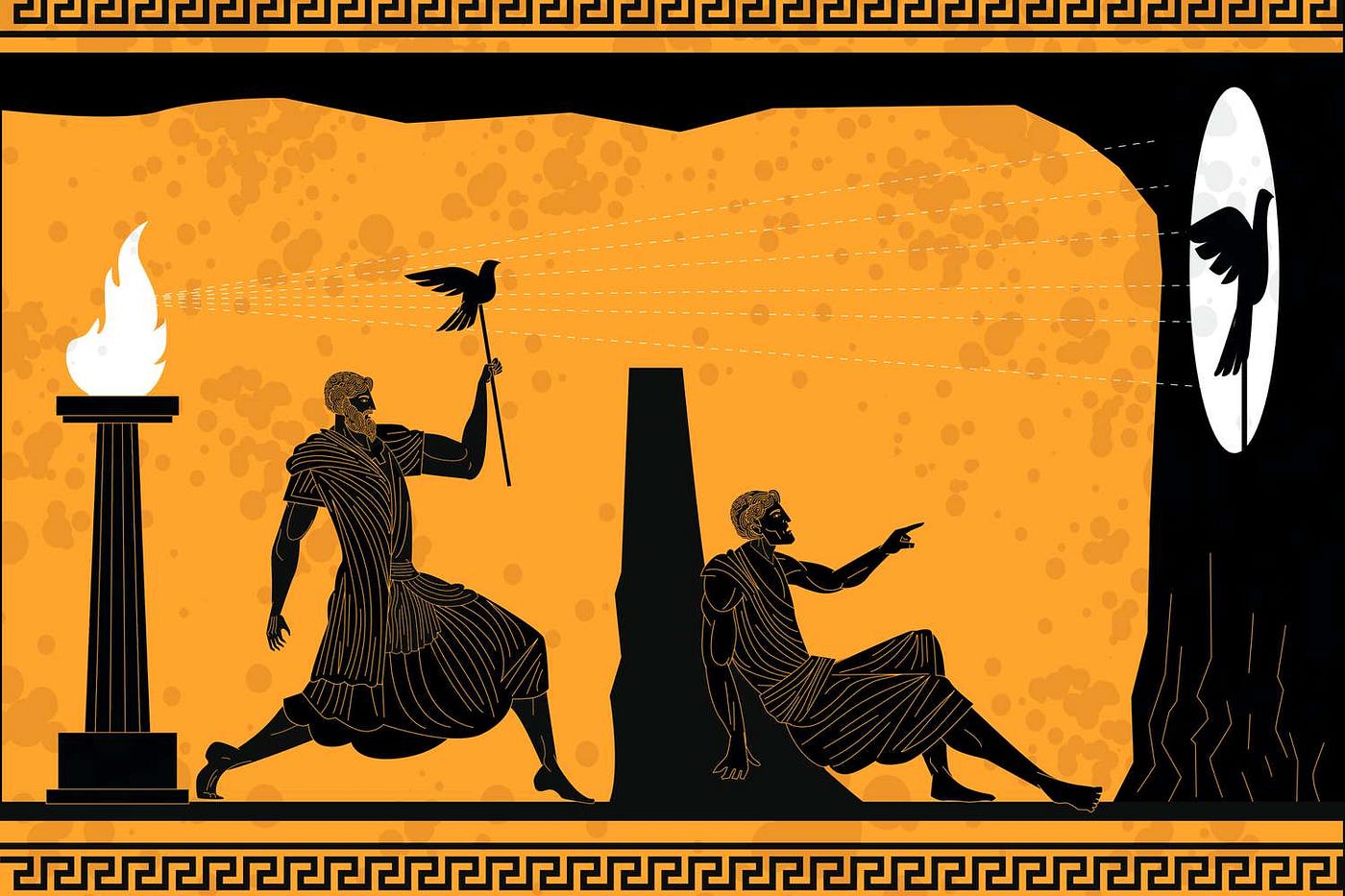
Deleuze and Guattari continue by describing the problem that arises when positioning desire in relation to acquisition:
From the moment that we place desire on the side of acquisition, we make desire an idealistic (dialectical, nihilistic) conception, which causes us to look upon it as primarily a lack: a lack of an object, a lack of the real object. (AO, 25)
When desire is framed in terms of acquisition, it is made into an idealistic, dialectical, and nihilistic concept. This perspective turns desire into an end goal, forever in search of attaining the perfect, lost object. In this manner, desire is understood in relation to lack — a deficiency or void that one seeks to fill by acquiring the lost object of desire.
- For the religious individual, one lacks God or holiness.
- For the capitalist, one lacks capital.
- For the psychoanalyst, one lacks the phallus.
Yet, we must not only conceptualize desire as acquisition; desire on the side of production hasn’t solely been absent:
It is true that the other side, the “production” side, has not been entirely ignored. (AO, 25)
Deleuze and Guattari characterize 18th-century German philosopher, Immanuel Kant, as offering a groundbreaking conceptualization of desire:
Kant, for instance, must be credited with effecting a critical revolution as regards the theory of desire, by attributing to it “the faculty of being, through its representations, the cause of the reality of the objects of these representations.” (AO, 25; emphasis mine)
Kant Citation — Start
In the quote above, Deleuze and Guattari reference the introduction to Kant’s book titled The Critique of Judgment, published in 1790, specifically citing a footnote:
But the following objection has been made to a similar explanation of the faculty of desire (Critique of Practical Reason, Preface, p. 16): that it cannot be defined as the faculty for being, through its representations, the cause of the reality of the objects of these representations, since mere wishes would also be desires, which, it is nevertheless admitted, cannot bring forth their objects. However, this proves nothing more than that there are also determinations of the faculty of desire in which it is in contradiction with itself: a phenomenon which is certainly noteworthy for empirical psychology (like noticing the influence that prejudices have on the understanding is for logic), but one which must not influence the definition of the faculty of desire considered objectively, that is, as it is in itself, before it is deflected from its determination by something else.
(Critique of the Power of Judgment, 32; emphasis mine)
As mentioned in the footnote above, Kant references his earlier work, Critique of Practical Reason, published in 1788. In this text (again, in another footnote), he writes:
The faculty of desire is a being’s faculty to be by means of its representations the cause of the reality of the objects of these representations.
(Critique of Practical Reason, 16; emphasis mine)
Kant Citation — End
Kant’s redefinition of desire is praised by Deleuze and Guattari (but is ultimately critiqued). The text from Kant is a bit confusing, so let’s clarify:
Kant’s view of desire departs from the traditional, Platonist notion of desire which conceptualizes desire in relation to acquiescence (also known as lack). For Platonism, something like hunger is understood in relation to lack: the subject lacks a sandwich (and attaining a sandwich would attempt to fulfill this lack). However, for Kant, desire is a productive force as “the faculty of being” — that is, human faculties (i.e., the subject’s mind) — represent objects and thus contribute to their existence. To use the previous example, Kant believes that when one is hungry, desire produces an image of a sandwich in the subject’s mind which causes the subject to go out and make a sandwich (or buy one).
Kant argues that desire is tied to the capacity for representation, meaning that objects of desire can exist conceptually in the mind even if they are not physically present. This approach emphasizes that desire involves an active process of representation(s), where the mind plays a crucial role in the existence and experience of desired objects.
— —
We will soon get to Deleuze and Guattari’s criticism of Kant’s view of desire, but as a side note, Kant’s argument has not been devoid of criticism writ large. Specifically, Kant has been criticized for including wishes within his definition of desire. If desire is defined as the capacity to cause or realize the reality of objects through representations, then wishes, which cannot always bring about their objects, would also fall under this definition. This inclusion leads to a contradiction because not all desires (e.g., wishes) result in the realization or actualization of their objects. This results in a contradiction (kantradiction?) within Kant’s definition of desire, as Kant doesn’t take into account the difference between desire and wishes.
Kant’s response to these criticisms is that, yes, there does exist an internal contradiction to the faculties of desire; however, Kant argues that we shouldn’t invalidate the concept of desire itself. Kant maintains that desire should be conceptualized as the capacity to represent and potentially realize objects, regardless of whether every instance of desire results in actual outcomes.
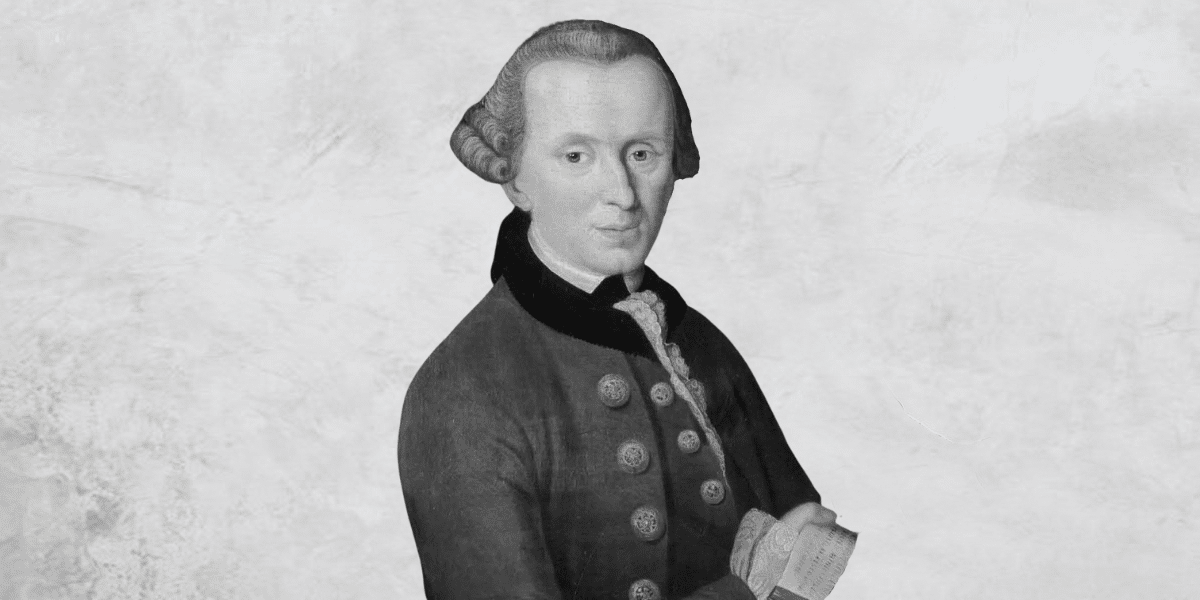
In any case, as we are reading Deleuze and Guattari’s works, we must focus on their criticism of Kant’s redefinition of desire. While they praise Kant’s departure from the traditional understanding of desire, they find that he doesn’t go far enough. Deleuze and Guattari write:
But it is not by chance that Kant chooses superstitious beliefs, hallucinations, and fantasies as illustrations of this definition of desire: as Kant would have it, we are well aware that the real object can be produced only by an external causality and external mechanisms; nonetheless this knowledge does not prevent us from believing in the intrinsic power of desire to create its own object — if only in an unreal, hallucinatory, or delirious form — or from representing this causality as stemming from within desire itself. (AO, 25)
Kant employs examples like hallucinations and superstitions to illustrate his definition of desire. Although Kant acknowledges that real objects are produced externally — with physical objects being produced from outside factors and not one’s mind (i.e., the sandwich is a real object that the subject makes or ends up buying)— Kant restricts desire to solely mental representations. Rather than conceptualizing desire as a process of production along with the sensations that produce subjectivity, Kant is limited in his view of desire as solely mental representations.
To summarize this point, we ought to refer to Chapter 1.3 where Deleuze and Guattari refer to hallucinations. They conclude that hallucinations and superstitions are the sole manifestation of desire fail to take into account a deeper I feel:
… The basic phenomenon of hallucination (I see, I hear) and the basic phenomenon of delirium (I think . . . ) presuppose an I feel at an even deeper level, which gives hallucinations their object and thought delirium its content. (AO, 18; emphasis mine)
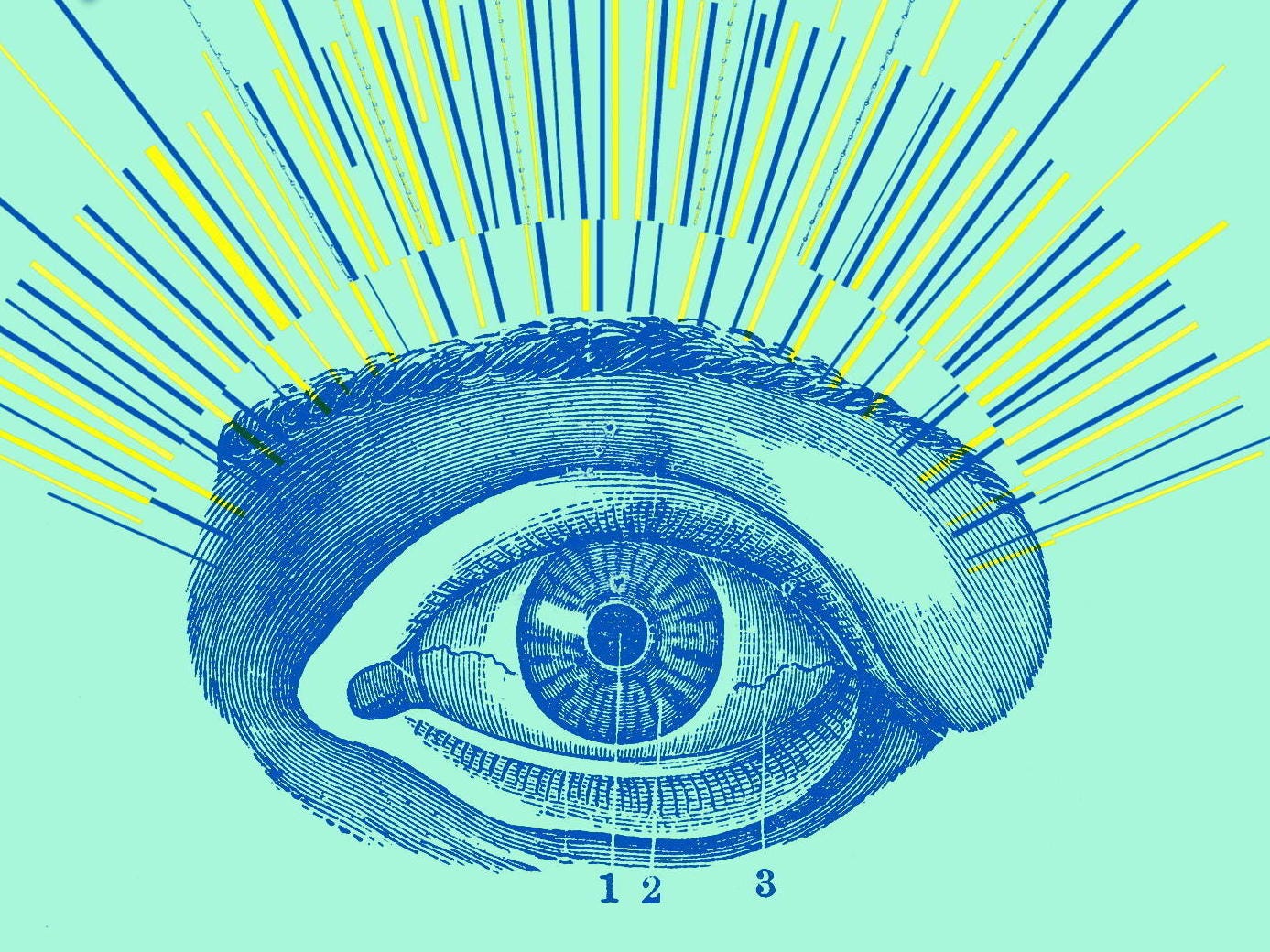
Thus, in Kant’s view:
The reality of the object, insofar as it is produced by desire, is thus a psychic reality. (AO, 25; emphasis mine)
Kant’s belief that desire solely produces a “psychic reality” (indicating that desire is divorced from a material reality) is a narrow and limited view. Therefore, Kant’s redefinition of desire — while groundbreaking — changes nothing important:
Hence it can be said that Kant’s critical revolution changes nothing essential: this way of conceiving of productivity does not question the validity of the classical conception of desire as a lack; rather, it uses this conception as a support and a buttress, and merely examines its implications more carefully. (AO, 25)
In Kant’s framework, desire in relation to lack or acquisition persists. Kant’s focus on representations and “psychic realities” highlights the erroneous notion that mental constructs and “psychic realities” are separate from an actualized, material reality. Kant’s understanding of desire asserts that when a subject desires, wishes, or hallucinates an object, this very subject is lacking something and fundamentally divorced from these objects. (Kant fails to take into account desiring-production, partial objects as he is starting from the position of a global person.) Thus, while desire may produce mental images or representations of objects, these representations are a means to address what the subject is lacking or missing in the material world.
To put simply, Kant views desire as a mechanism aimed at addressing a lack. Instead, Deleuze and Guattari view desire as a productive force where they blur the lines between materiality and immateriality. There is no psychic reality, desire, wish, or series of hallucinations that exist independently from the subject being produced by feelings and sensations. The “I feel” precedes everything.
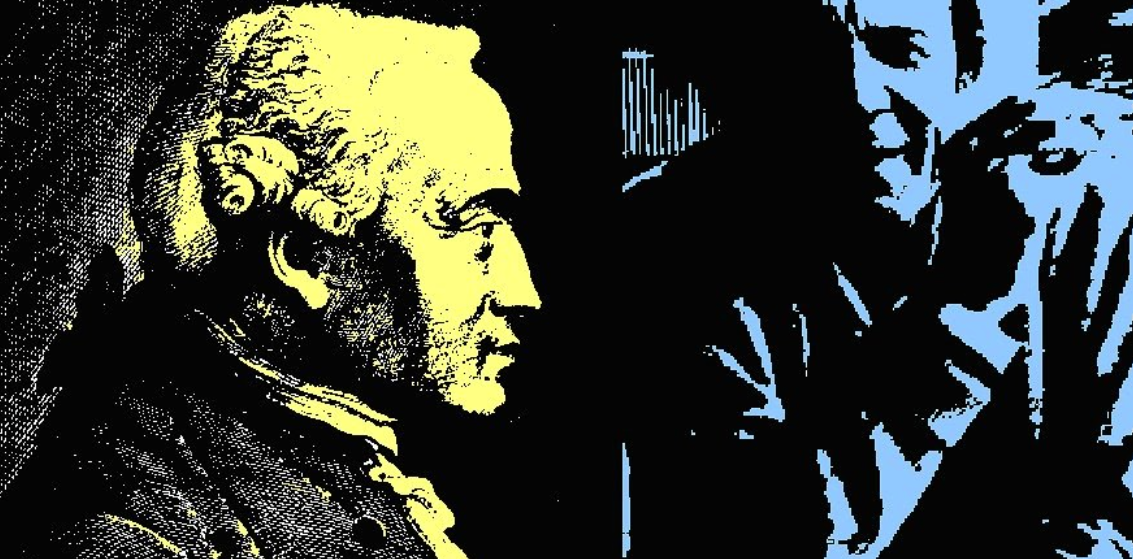
Paragraph Eight
Deleuze and Guattari continue:
In point of fact, if desire is the lack of the real object, its very nature as a real entity depends upon an “essence of lack” that produces the fantasized object. (AO, 25)
Here, Deleuze and Guattari argue that if desire is fundamentally linked to lack or acquisition, then the fantasized objects inherently possess an “essence of lack.” This perspective allows psychoanalysis to seamlessly explain desire producing fantasies:
Desire thus conceived of as production, though merely the production of fantasies, has been explained perfectly by psychoanalysis. (AO, 25)
Now … how do we interpret this? Deleuze and Guattari write:
On the very lowest level of interpretation, this means that the real object that desire lacks is related to an extrinsic natural or social production, whereas desire intrinsically produces an imaginary object that functions as a double of reality, as though there were a “dreamed-of object behind every real object,” or a mental production behind all real productions. (AO, 25–26)
Deleuze and Guattari argue that if we accept the idea that desire is in relation to lack, then the real object that is supposedly missing or absent relates to external social or environmental factors outside of the individual (i.e., one desires an object because they lack it). In response to this lack, desire internally generates a fantasy object that acts as a substitute for the real thing. This fantasy object serves as a “double of reality” — an imagined version that stands in for the real object. In this framework, every real object is obfuscated by an imaginary version of said object (“a mental production behind all real productions”).
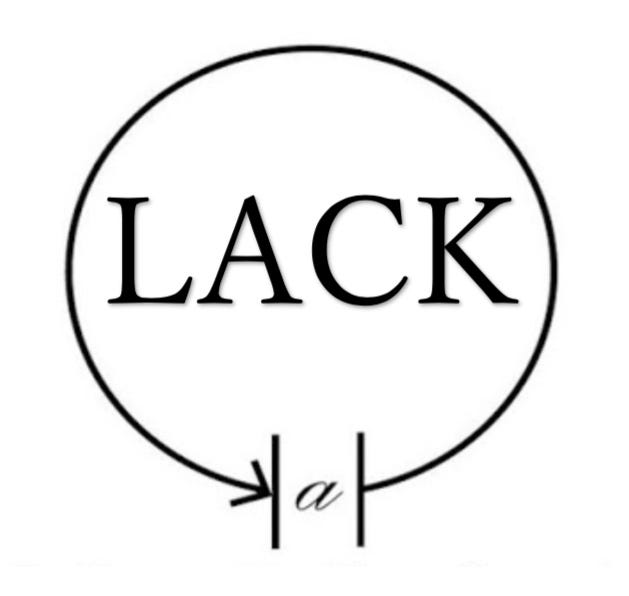
Deleuze and Guattari go on to explain (while mocking psychoanalysis) that psychoanalysis isn’t inherently forced to psychoanalyze mundane objects, but it logically runs the risk of doing so:
This conception does not necessarily compel psychoanalysis to engage in a study of gadgets and markets, in the form of an utterly dreary and dull psychoanalysis of the object: psychoanalytic studies of packages of noodles, cars, or “thingumajigs.” (AO, 26)
Though psychoanalysis can engage in the study of noodles or cars, it tends not to. However, even with Kant’s reiteration of desire, there is this theatrical element to psychoanalysis:
But even when the fantasy is interpreted in depth, not simply as an object, but as a specific machine that brings desire itself front and center, this machine is merely theatrical, and the complementarity of what it sets apart still remains: it is now need that is defined in terms of a relative lack and determined by its own object, whereas desire is regarded as what produces the fantasy and produces itself by detaching itself from the object, though at the same time it intensifies the lack by making it absolute: an “incurable insufficiency of being,” an “inability-to-be that is life itself.”
(AO, 26; emphasis mine)
Deleuze and Guattari are not only critiquing psychoanalysis, but they are also critiquing Kant’s reiteration of desire and how this view of desire remains tied to the idea of lack (thus, tied to the psychoanalytic approach of desire). In Kant’s system, desire is still confined to a relationship with an object — with the object represented as a psychic reality (in one’s mind). Even when interpreting fantasy in depth, this view confines desire to representations. The object of desire is produced as a psychic reality and the subject lacks the real object. This conceptualization of fantasy serving as a machine or motor for representations is described as “theatrical,” where the unconscious becomes a stage with the (lost) object of desire playing a lead role.
To sum up this unfortunate progression:
Hence the presentation of desire as something supported by needs, while these needs, and their relationship to the object as something that is lacking or missing, continue to be the basis of the productivity of desire (theory of an underlying support). (AO, 26; emphasis mine)
To clarify the argument presented above, Deleuze and Guattari write:
In a word, when the theoretician reduces desiring-production to a production of fantasy, he is content to exploit to the fullest the idealist principle that defines desire as a lack, rather than a process of production, of “industrial” production. (AO, 26)
Whether in Kant, Freud, or Lacan, reducing desiring-production to the mere production of fantasy is arbitrary, severing desire from its productive process and placing it on a pedestal and declared unattainable. On this point, Deleuze and Guattari praise French philosopher and writer Clément Rosset for explaining this criticism well:
Clement Rosset puts it very well: every time the emphasis is put on a lack that desire supposedly suffers from as a way of defining its object, “the world acquires as its double some other sort of world, in accordance with the following line of argument: there is an object that desire feels the lack of; hence the world does not contain each and every object that exists; there is at least one object missing, the one that desire feels the lack of; hence there exists some other place that contains the key to desire (missing in this world).” (AO, 26)
In this quote, Deleuze and Guattari cite Rosset’s 1970 text Logique du pire (translated as Logic of the Worst). In Logique du pire, Rosset examines how people tend to imagine worst-case scenarios and project a negative version of reality onto the actual world, which leads to unnecessary suffering. This introduction of a negative counterpart (a negative world) parallels how Deleuze and Guattari critique psychoanalysis’ view of desire. As Rosset’s quote illustrates, psychoanalysis, by positioning desire in relation to lack, presupposes that the world is inherently incomplete or that there is always something missing. This leads to the imagination of an alternate realm where the missing object resides. As a result, desire is seen as insatiable within the material world, driving us to seek fulfillment of that lack through transcendental means.

Paragraph Nine
With all this discussion of desire, it’s important to ask: how do Deleuze and Guattari actually understand desire? They write:
If desire produces, its product is real. If desire is productive, it can be productive only in the real world and can produce only reality. Desire is the set of passive syntheses that engineer partial objects, flows, and bodies, and that function as units of production. The real is the end product, the result of the passive syntheses of desire as autoproduction of the unconscious. (AO, 26)
- Note: Deleuze and Guattari usethe term “passive” to describe the syntheses, which suggests that they are contesting the idea of an agent performing an action (since Deleuze and Guattari are dealing with partial objects instead of global persons). This terminology is also drawn from Difference and Repetition, where Deleuze examines the “active synthesis” in relation to conscious activity.
Unlike psychoanalysis positioning desire in relation to lack, Deleuze and Guattari view desire to be a productive force. Desire produces reality with the ‘real’ being the ultimate outcome of this production process.
They proceed to dismantle the notion of desire being defined in relation to lack:
Desire does not lack anything; it does not lack its object. It is, rather, the subject that is missing in desire, or desire that lacks a fixed subject; there is no fixed subject unless there is repression.
(AO, 26; emphasis mine)
In Chapter 1.3, we observed the presence of a subject traversing the surface of the body without organs. Here, Deleuze and Guattari emphasize that desire does not have a fixed subject (with this fixed subject being a Cartesian subject produced transcendentally). For them, beginning with the Cartesian subject implies starting with a global person. However, it is important to note that Deleuze and Guattari begin their discussion with partial objects and explain how the subject is continuously produced through the three syntheses, ultimately rising in the third synthesis.
At any rate, desire doesn’t lack anything. It doesn’t lack its object because … :
Desire and its object are one and the same thing: the machine, as a machine of a machine. Desire is a machine, and the object of desire is another machine connected to it. Hence the product is something removed or deducted from the process of producing: between the act of producing and the product, something becomes detached, thus giving the vagabond, nomad subject a residuum. (AO, 26; emphasis mine)
This passage critiques the concept of “lack.” In the Platonic and psychoanalytic traditions, desire is explained in relation to a perceived absence — one desires something precisely because it is something they do not have. However, in Deleuze and Guattari’s critique, desire is not understood in relation to lack because desire and its object are the same. Desiring-machines are connected to other desiring-machines within an interconnected network; lack, then, is not a natural, inherent quality but something erroneously produced (more of this will be discussed in Chapter 2). Regardless, in the framework of desiring-production, the relationship between production and product gives rise to a subject found in Chapter 1.3.
Deleuze and Guattari continue:
The objective being of desire is the Real in and of itself.* (AO, 26–27)
*Footnote: “Lacan’s admirable theory of desire appears to us to have two poles: one related to “the object small a” as a desiring-machine, which defines desire in terms of a real production, thus going beyond both any idea of need and any idea of fantasy; and the other related to the “great Other” as a signifier, which reintroduces a certain notion of lack. In Serge Leclaire’s article “La re’alite du desir” (Ch. 4, reference note 26), the oscillation between these two poles can be seen quite clearly.”
At this point, Deleuze and Guattari include a footnote explaining that the “object small a” (objet petit a) in psychoanalysis functions as a legitimate desiring-machine due to French psychoanalyst Jacques Lacan linking the object small a to real production. However, they identify a problem with Lacan’s “great Other,” which acts as a signifier that renders these desiring-machines (or object small a) into unattainable objects of desire, situating desire into the framework of deficiency. In reality, desire has always been the production of the Real; for Deleuze and Guattari, it has always been the Real.
With all considering, Deleuze and Guattari reinforce their position by critiquing the notion of desire as solely being “psychic” — a term used by Kant, which has already been critiqued above:
There is no particular form of existence that can be labeled “psychic reality.” (AO, 27)
To make this point clearer, Deleuze and Guattari directly reference Marx:
As Marx notes, what exists in fact is not lack, but passion, as a “natural and sensuous object.” (AO, 27)
This quote appears to be a reference to to Marx’s Economic and Philosophic Manuscripts of 1844 — specifically in the section titled ‘Critique of Hegel’s Philosophy in General’ — where Marx states:
To say that [hu]man is a corporeal, living, real, sensuous, objective being full of natural vigour is to say that [they have] real, sensuous objects as the object of [their] being or of [their] life, or that [they] can only express [their] life in real, sensuous objects. To be objective, natural and sensuous, and at the same time to have object, nature and sense outside oneself, or oneself to be object, nature and sense for a third party, is one and the same thing. (Economic and Philosophic Manuscripts of 1844)
In this way, Marx emphasizes the material and embodied aspects of human existence, where human life is defined not by lack, but by passion and real, tangible, sensuous objects. Regardless, many people understand desire in relation to need — particularly since the word “desire” is often used that way in everyday language — but it’s not need that bolsters desire; rather, it’s the opposite:
Desire is not bolstered by needs, but rather the contrary; needs are derived from desire: they are counterproducts within the real that desire produces. (AO, 27; emphasis mine)
In this way, needs serve as intensive quantities consumed in the third synthesis. In the same way that needs are derived from desire, so is lack:
Lack is a countereffect of desire; it is deposited, distributed, vacuolized within a real that is natural and social. (AO, 27; emphasis mine)
Lack being understood as a “countereffect of desire” implies that lack is produced by desire while manifesting within the real as an effect of desire. (The distinction between counterproducts and countereffects may be nomial, but this will be examined more in-depth in Chapter 10). When lack is understood as “deposited” and “distributed,” Deleuze and Guattari are explaining that lack, when produced, constitutes the Real and is “vacuolized” in the sense that lack serves as the creation of a gap or absence.
- “Vacuoles” is a biological term referring to storage structures within cells serving as a sort of empty space.
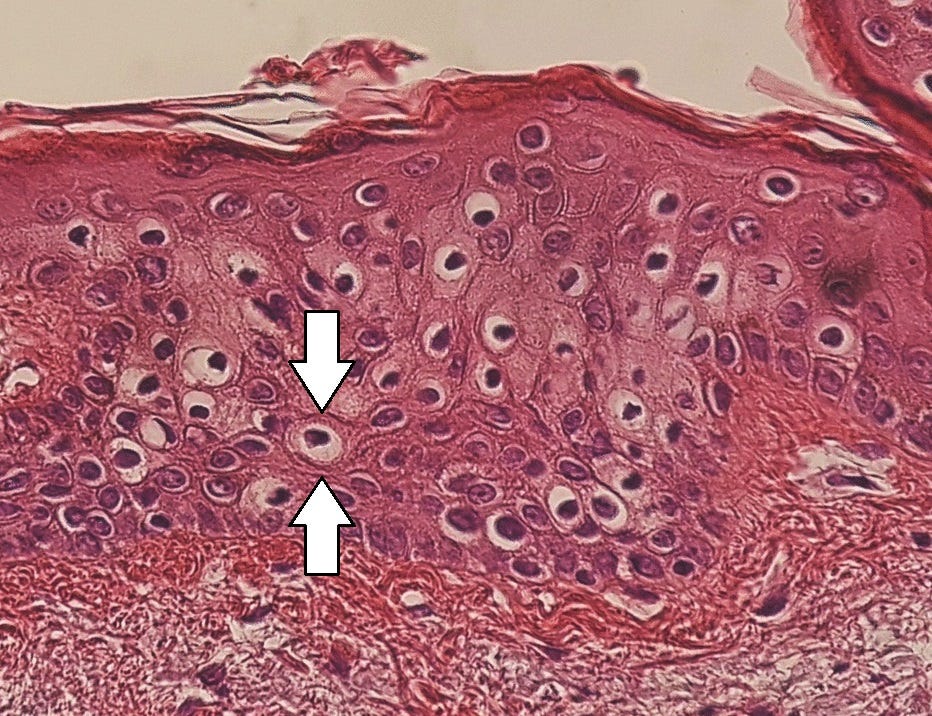
Deleuze and Guattari continue:
Desire always remains in close touch with the conditions of objective existence; it embraces them and follows them, shifts when they shift, and does not outlive them. For that reason it so often becomes the desire to die, whereas need is a measure of the withdrawal of a subject that has lost its desire at the same time that it loses the passive syntheses of these conditions. (AO, 27)
In this passage, Deleuze and Guattari discuss the dual nature of desire, which encompasses both life and death, challenging Freud’s notion of the “death instinct” (refer to Chapter 1.1). They argue that death is not merely an endpoint but a productive force in desiring-production. The “conditions of objective existence” that Deleuze and Guattari refer to are in a perpetual state of living and dying. As noted in Chapter 1.3, the subject undergoes constant rebirth through the consummation of intensive quantities, indicating that as it is reborn, it is also continually dying. Since desire is intertwined with its object, it does not separate from the object as it dies; instead, new conditions of objective experience emerge from this death. Ultimately, they conclude by asserting that needs serve as a counter-product of desire, as it “loses the passive syntheses of these conditions,” functioning as an active element in the unconscious.
They proceed:
This is precisely the significance of need as a search in a void: hunting about, trying to capture or become a parasite of passive syntheses in whatever vague world they may happen to exist in. (AO, 27)
This analysis further distinguishes need from desire, implicitly arguing that need should not be synonymous with desire. Need is linked to a “search in a void,” which captures the passive syntheses of the unconscious. When the subject says, “I need food,” it implies an awareness or consciousness of that need, but this understanding tends to reduce need as a mere starting and end point. However, need does not exist in isolation; need is constituted and produced by desire which creates connections and disconnections, emitting and interrupting flows that generate bodily sensations. Thus, the statement “I need food” emerges only after this complex interplay of desire. Further still:
It is no use saying: We are not green plants; we have long since been unable to synthesize chlorophyll, so it’s necessary to eat. . . . Desire then becomes this abject fear of lacking something. (AO, 27)
In this quote, Deleuze and Guattari critique the simplistic narratives that portray humans as uniquely burdened by desires that can never be fully satisfied, unlike plants that easily absorb sunlight. Deleuze and Guattari argue that this perspective fails by tying desire to a sense of lack or deficiency, leading us to believe that we are never consuming enough. Desire, for humans, is just as simple as desire in relation to a plant absorbing sunlight. Touch grass!
We must view desire as a productive force:
But it should be noted that [“we are not green plants”] is not a phrase uttered by the poor or the dispossessed. On the contrary, such people know that they are close to grass, almost akin to it, and that desire “needs” very few things — not those leftovers that chance to come their way, but the very things that are continually taken from them — and that what is missing is not things a subject feels the lack of somewhere deep down inside himself, but rather the objectivity of man, the objective being of man, for whom to desire is to produce, to produce within the realm of the real.
(AO, 27)
Deleuze and Guattari emphasize that this sense of lack, along with the associated fear, is not limited to individuals who are part of marginalized groups. In fact, those in lower societal positions are often “close to the grass,” meaning they are more attuned to desire. The desires of these marginalized individuals are not centered around excess of “leftovers” and meaningless goods, but rather revolve around the fundamental aspects of life that are constantly denied to them, such as dignity and basic resources. These subjects are not focused on an abstract, internal sense of lack, but on the material structures and societal conditions that shape their experiences.
Paragraph Ten
All of this culminates in desire producing the real; it’s always been the real:
The real is not impossible; on the contrary, within the real everything is possible, everything becomes possible. (AO, 27)

They continue:
Desire does not express a molar lack within the subject; rather, the molar organization deprives desire of its objective being. (AO, 27)
This is the first time where Deleuze and Guattari employ the term “molar,” emphasizing macro-level organization and rigid stability. Rather than diving into the specificities between the molar and molecular (which will be explained in depth later), we must note that desire does not represent a fundamental absence within the subject; desire does not express a molar organization of subjectivity as defined by the Cartesian subject. Rather, molar organization creates rigid subjects, and deprives desire of its “objective being,” making desire appear subjective in nature.
However, Deleuze and Guattari note that there are specific subjects that are keen on being objective:
Revolutionaries, artists, and seers are content to be objective, merely objective: they know that desire clasps life in its powerfully productive embrace, and reproduces it in a way that is all the more intense because it has few needs. And never mind those who believe that this is very easy to say, or that it is the sort of idea to be found in books.
(AO, 27; emphasis mine)
The specific subjects listed — revolutionaries, artists, and seers — are content with decentering the self in an objective way, embracing the powerful (albeit loosely defined) nature of desiring-production. At the end of this quote, Deleuze and Guattari playfully poke fun at themselves by saying that the objective nature of these subjects cannot be found in books — yet we are encountering this idea within a book, adding a facetious touch. It appears that they are suggesting that books, probably specific to the philosophical kind, reduce or over-theorize ideas, turning them into something abstract rather than something lived or experienced.

Ironically enough, after making fun of the notion that these objective contents can be found in books, Deleuze and Guattari go on to reference the American novelist Henry Miller and his 1949 book Sexus:
“From the little reading I had done I had observed that the men who were most in life, who were moulding life, who were life itself, ate little, slept little, owned little or nothing. They had no illusions about duty, or the perpetuation of their kith and kin, or the preservation of the State. . . . The phantasmal world is the world which has never been fully conquered over. It is the world of the past, never of the future. To move forward clinging to the past is like dragging a ball and chain.”
(AO, 27–28; emphasis mine)
Sexus is the opening book of The Rosy Crucifixion trilogy, a semi-autobiographical series that chronicles six years of Miller’s life. Adding yet another layer of irony, Miller’s quoted passage reflects on his experience reading books and observing that those who didn’t focus on accumulating wealth were the ones truly “most in life.”
Deleuze and Guattari go on to describe what those who are “most in life” appear to be like:
The true visionary is a Spinoza in the garb of a Neapolitan revolutionary. (AO, 28)
By invoking 17th Century Baruch Spinoza, one of Deleuze and Guattari’s most idolized philosophers, as a “Neapolitan revolutionary”, they are painting the image of an individual who couples deep, philosophical thought with radical action. This also references a moment in Deleuze’s Spinoza: Practical Philosophy published in 1970 where he writes about how Spinoza used to draw himself “in the attitude and costume of the Neapolitan revolutionary Masaniello.”
They continue:
We know very well where lack — and its subjective correlative — come from. (AO, 28)
- This “subjective correlative” refers to “molar organization depriving desire of its objective being” and transformed into something deemed subjective.
Lack (manque)* is created, planned, and organized in and through social production. (AO, 28)
Let’s start with the translators’ note:
*The French word manque may mean both lack and need in a psychological sense, as well as want or privation or scarcity in an economic sense. Depending upon the context, it will hence be translated in various ways below. (Translators’ note.)
In the translators’ note, they isolate that the French word “manque” has the ability to mean “lack and need in a psychological sense.” As stated earlier, lack is understood as a countereffect of desire, while need is understood as a counterproduct of desire. However, when “need” is conceptualized in this psychological sense, that is to say, thought of as preceding desire, it is akin to lack.
This is why, in the sentence directly after, Deleuze and Guattari write:
(Manque) is counterproduced as a result of the pressure of antiproduction; the latter falls back on (se rabat sur) the forces of production and appropriates them. (AO, 28; emphasis mine)
Notice how the word “manque” is used in the sense of being “counterproduced.” And also notice that they purposefully used the word “manque” instead of “besoin” (which is the French word for “need”) This seems to indicate that lack and need are functionally the same when understood as a counterproduction that is a “result of the pressure of antiproduction.”

Now that we’ve cleared up some confusion, let’s review those quotes with more precision:
Lack (manque) is created, planned, and organized in and through social production. (AO, 28)
At this juncture, Deleuze and Guattari present social production as a key factor in the creation of lack. In Chapter 1.2, we observed the connection between desiring-production and social production; however, Deleuze and Guattari do not thoroughly explore why “lack is created through social production” here. In the eleventh paragraph, we will discover that social production is, in essence, desiring-production “under determinate conditions”, meaning that these conditions influence the creation of lack.
Furthermore:
(Manque) is counterproduced as a result of the pressure of antiproduction; the latter falls back on (se rabat sur) the forces of production and appropriates them. (AO, 28; emphasis mine)
Lack is counterproduced by desire through social production, and due to the body without organ’s antiproductive nature, the body without organs falls back upon (se rabat sur) the process of production. Consequently, lack is continuously appropriated, making it seem as though lack emanates from the surface of recording. Because of this. Deleuze and Guattari reiterate their earlier thesis that need and lack are not pre-existing or primary:
[Manque] is never primary; production is never organized on the basis of a pre-existing need or lack (manque).
(AO, 28)
It is lack that infiltrates itself, creates empty spaces or vacuoles, and propagates itself in accordance with the organization of an already existing organization of production.*
(AO, 28; emphasis mine)
In a footnote here, Deleuze and Guattari cite French writer Maurice Clavel’s critique of French existentialist Jean-Paul Sartre, emphasizing Clavel’s observation that Marx was wise to not define scarcity as a starting premise of capitalism. Had Marx done so, it would imply that supply and demand operate as fundamental, unchangeable forces, rather than a result of specific sociohistorical conditions. This approach suggests that Marx viewed scarcity not as a natural, inherent drive toward fulfilling a lack but as something constructed within the capitalist system. In parallel, Deleuze and Guattari argue that lack is not a natural state but is created by a pre-existing system of production, which organizes desire and need according to the demands of the capitalist structure.
At any rate, to analyze the quote above more directly, lack embeds itself by continually generating empty spaces with, establishing the very sense of lack that it produces. Deleuze and Guattari make clear that lack doesn’t emerge from somewhere outside of the production process — it aligns itself with the organization of “an already existing organization of production.” To explain this point more clearly, Deleuze and Guattari parallel the creation of lack to a market economy, like that of capitalism. They write:
The deliberate creation of lack as a function of market economy is the art of a dominant class. This involves deliberately organizing wants and needs (manque) amid an abundance of production; making all of desire teeter and fall victim to the great fear of not having one’s needs satisfied; and making the object dependent upon a real production that is supposedly exterior to desire (the demands of rationality), while at the same time the production of desire is categorized as fantasy and nothing but fantasy. (AO, 28; emphasis mine)
- Deleuze and Guattari make a strategic move here by highlighting how desire is relegated to the realm of fantasy under capitalism — a term Lacan uses to describe a bridge between desire and reality. Yet, they note that desire was never fantasy — it’s always been real.
- The phrase “demands of rationality” refers to how the transcendent concept of rationality is produced alongside this process, upholding this production of lack.
In the market economy, lack is deliberately constructed amidst abundant production, created a system where everyone could, theoretically, have their basic needs met but are, instead, made to feel constant insecurity. Within a system of capitalism, desire is always understood as something unfulfilled, fueling an endless cycle of wanting. This process disconnects the object of desire from desire itself, reducing desire’s productive capacity to mere “fantasy” rather than recognizing desire as a real, productive force.

Paragraph Eleven
Deleuze and Guattari begin this paragraph by problematizing the false dichotomy between social production and desiring-production:
There is no such thing as the social production of reality on the one hand, and a desiring-production that is mere fantasy on the other. (AO, 28)
It is not enough to say that social production produces reality and desiring-production produces fantasy. The notion that we can draw a simple, straightforward connection between social production and desiring-production lies in a reductive framework as they are both interconnected, simultaneously shaping one another. Deleuze and Guattari write:
The only connections that could be established between these two productions would be secondary ones of introjection and projection, as though all social practices had their precise counterpart in introjected or internal mental practices, or as though mental practices were projected upon social systems, without either of the two sets of practices ever having any real or concrete effect upon the other. (AO, 28; emphasis mine)
Deleuze and Guattari dismiss the idea of secondary connections between social production and desiring-production, arguing that such connections are solely based on introjection and projection. This means that efforts to align social production with internal psychological processes (introjection) or to correspond internal psychological processes with social production (projection) are overly simplistic. This simplification is problematic because it neglects to demonstrate how these two forms of production actively effect one another.

For the sake of enjoyment, let’s imagine a perfect parallel between the two forms of production:
As long as we are content to establish a perfect parallel between money, gold, capital, and the capitalist triangle on the one hand, and the libido, the anus, the phallus, and the family triangle on the other, we are engaging in an enjoyable pastime, but the mechanisms of money remain totally unaffected by the anal projections of those who manipulate money. (AO, 28)
Deleuze and Guattari suggest that while we can imagine a parallel between capitalism as a form of social production (capitalist triangle) and the oedipalized unconscious (family triangle), this does not change the fundamental reality that money is exchanged regardless of the psychological projections of those who handle it. Thus:
The Marx-Freud parallelism between the two remains utterly sterile and insignificant as long as it is expressed in terms that make them introjections or projections of each other without ceasing to be utterly alien to each other, as in the famous equation money = shit. (AO, 28–29)
- When Deleuze and Guattari assert that “money = shit,” they are making a provocative statement that highlights Marx’s focus on the exchange of money and Freud’s emphasis on feces in the anal stage, which symbolizes a child’s relationship with their parents, often characterized as “anal-retentive” or “anal-expulsive.”
The false dichotomy between social production and desiring-production that arises from Marx’s exclusive focus on the political economy and Freud’s exclusive focus on the libidinal economy is flawed. This narrow framing relies on introjection or projection, obscuring the intricate relationship between the two. As we will soon learn: the political economy and libidinal economy are one and the same thing; or rather, two sides of the same coin.
Deleuze and Guattari conclude this paragraph by describing the true relationship between social production and desiring-production:
The truth of the matter is that social production is purely and simply desiring-production itself under determinate conditions. We maintain that the social field is immediately invested by desire, that it is the historically determined product of desire, and that libido has no need of any mediation or sublimation, any psychic operation, any transformation, in order to invade and invest the productive forces and the relations of production. There is only desire and the social, and nothing else. (AO, 29)
To reiterate: social production is desiring-production under determinate conditions. From my understanding, these “determinate conditions” manifest as social structures and historical conditions; they are the frameworks by which we conceptualize society. However, as it must be stated clearly: the social field and desire and intrinsically connected — there is “no need of any mediation” between the two.
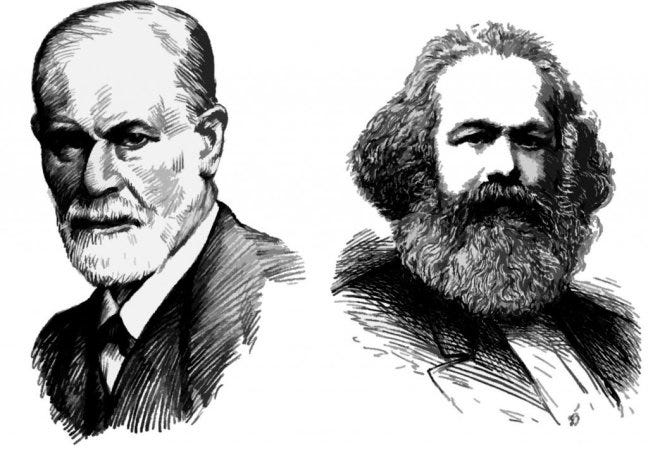
Paragraph Twelve
Though desire is presented as a sort of liberatory force throughout Chapters 1.1–1.3, we must not assume that desire isn’t responsible for problematic forms of social production:
Even the most repressive and the most deadly forms of social reproduction are produced by desire within the organization that is the consequence of such production under various conditions that we must analyze. (AO, 29)
That said, Deleuze and Guattari pose two fundamental questions that form the basis of the issues addressed in Anti-Oedipus. (This might be my favorite part of the work):
That is why the fundamental problem of political philosophy is still precisely the one that Spinoza saw so clearly, and that Wilhelm Reich rediscovered: “Why do men fight for their servitude as stubbornly as though it were their salvation?” How can people possibly reach the point of shouting: “More taxes! Less bread!”?
(AO, 29; emphasis mine)
- The quote “More taxes! Less bread!” comes from the first chapter of Lewis Carroll’s 1889 novel Sylvie and Bruno, which is titled Less Bread! More Taxes!
It may seem surprising that individuals vote for leaders who are directly opposed to their interests (whether it be opposing healthcare, tax cuts for the rich, etc.), yet most do not question this behavior. Consequently, the questions raised by Deleuze and Guattari (or, more accurately, by Spinoza and Austrian psychoanalyst Wilhelm Reich) are largely intuitive.

Deleuze and Guattari proceed by building on Reich’s work:
As Reich remarks, the astonishing thing is not that some people steal or that others occasionally go out on strike, but rather that all those who are starving do not steal as a regular practice, and all those who are exploited are not continually out on strike: after centuries of exploitation, why do people still tolerate being humiliated and enslaved, to such a point, indeed, that they actually want humiliation and slavery not only for others but for themselves?
(AO, 29; emphasis mine)
Reich is correct to point out that we shouldn’t be surprised as to why some individuals resort to theft — after all, some people will inevitably steal in an inequitable economic system. What is truly surprising is that theft isn’t a common practice among those who are starving. Another example he offers is that individuals don’t frequently go on strike when they are exploited at work. However, it’s important to recognize that Deleuze and Guattari are not merely claiming that people simply endure or tolerate these conditions; rather, they assert that people actually desire these conditions for themselves and others.
As Deleuze and Guattari assert:
Reich is at his profoundest as a thinker when he refuses to accept ignorance or illusion on the part of the masses as an explanation of fascism, and demands an explanation that will take their desires into account, an explanation formulated in terms of desire: no, the masses were not innocent dupes; at a certain point, under a certain set of conditions, they wanted fascism, and it is this perversion of the desire of the masses that needs to be accounted for. (AO, 29)
In this vein, Reich is correct in maintaining that “the masses were not innocent dupes” and we cannot blame ignorance as the cause of their acceptance of fascism. They wanted fascism.
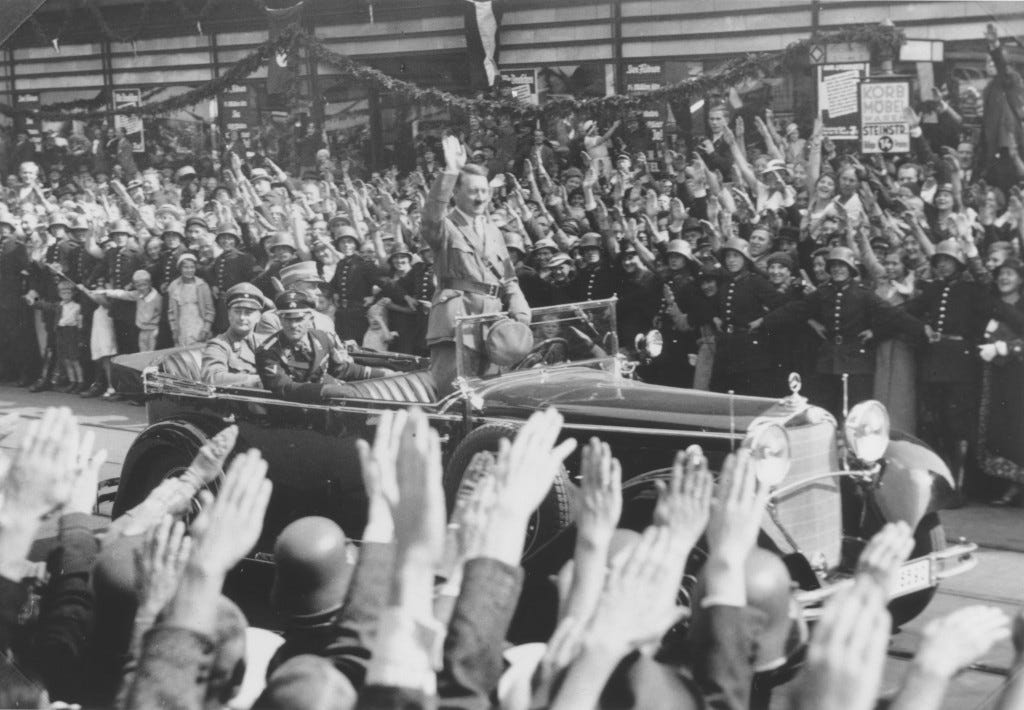
Paragraph Thirteen
Before they praise Reich too much, Deleuze and Guattari note Reich’s error:
Yet Reich himself never manages to provide a satisfactory explanation of this phenomenon, because at a certain point he reintroduces precisely the line of argument that he was in the process of demolishing, by creating a distinction between rationality as it is or ought to be in the process of social production, and the irrational element in desire, and by regarding only this latter as a suitable subject for psychoanalytic investigation.
(AO, 29)
The issue with Reich is that he never fully explained the why behind people wanting fascism. Instead, he fell back into a reductive framework separating rationality in social production from the irrational nature of desire, codifying a separation between social production and desiring-production. Furthermore:
Hence the sole task [Reich] assigns psychoanalysis is the explanation of the “negative,” the “subjective,” the “inhibited” within the social field. He therefore necessarily returns to a dualism between the real object rationally produced on the one hand, and irrational, fantasizing production on the other.* (AO, 29–30)
- *This footnote highlights that proponents of culturalism, including American psychoanalyst Abram Kardiner’s work, who argue that culture human behavior and social structures, differentiate between “rational systems” and irrational “projective systems,” with psychoanalysis only applicable to the latter. Although Reich and his contemporary, German-American philosopher Herbert Marcuse, critique culturalism for being overly simplistic, they inadvertently reinforce a dualistic framework by maintaining a distinction between “rational” and “irrational” desires, albeit in very different ways.
In this way, Reich confines psychoanalysis to addressing the negative and problematic aspects of desire present within the social field. This leads to a dualism that separates desire from its real objects, indicating that while real objects are produced through rational social processes, the irrational aspects of desire exist in the realm of fantasy. Deleuze and Guattari’s criticism of Reich can be summed up in one sentence:
He gives up trying to discover the common denominator or the coextension of the social field and desire. (AO, 30)
In response to the crafting of a false separation between social production and desiring-production, Deleuze and Guattari emphasize the necessity of a materialist psychiatry:
In order to establish the basis for a genuinely materialistic psychiatry, there was a category that Reich was sorely in need of: that of desiring-production, which would apply to the real in both its so-called rational and irrational forms. (AO, 30)
Desire has always been a question of producing the real — to which, at least according to Reich, exists rational and irrational forms of desire. A materialist psychiatry recognizes that social production is desiring-production under determinate conditions.
Paragraph Fourteen
They proceed:
The fact there is massive social repression that has an enormous effect on desiring-production in no way vitiates our principle: desire produces reality, or stated another way, desiring-production is one and the same thing as social production. (AO, 30)
Deleuze and Guattari note that social repression has an effect on desiring-production as social production crafts a type of pathway for desiring-production; hence, why capitalism relies on crafting an endless wanting amidst abundant production. However, none of this corrupts Deleuze and Guattari’s thesis: desiring-production is the same as social production.
Once more, let’s reiterate what has been expressed numerous times:
It is not possible to attribute a special form of existence to desire, a mental or psychic reality that is presumably different from the material reality of social production. (AO, 30)

In Chapters 1.1, 1.2, and 1.3, we find a detailed analysis of the three syntheses of the unconscious. At this point, it is evident that Deleuze and Guattari are criticizing the rigidity of psychiatric institutions.
Desiring-machines are not fantasy-machines or dream-machines, which supposedly can be distinguished from technical and social machines. Rather, fantasies are secondary expressions, deriving from the identical nature of the two sorts of machines in any given set of circumstances. (AO, 30; emphasis mine)
- In the original French text, the first sentence roughly translates to: “Desiring machines are not fantastical or dreamlike machines, which would be distinguished from technical and social machines, and would double them.” The word “double” is important here because it suggests that conceptualizing desiring-machines as fantasy-machines would inherently create a ‘doubling’ of reality — a key foundation of psychoanalysis where the ‘imaginary’ and ‘symbolic’ registers are divorced from the real.
Desiring-machines do not belong to a world of fantasy or symbolic representation but are material machines that operate within the same reality as “technical and social machines.” Fantasies, therefore, are not foundational; they are “secondary expressions” that emerge from the interaction between desiring-machines and social machines, which are fundamentally the same.
Technical Machines — Start
The passage above marks the first use of the term “technical machines” by Deleuze and Guattari. While this concept will be explored further in the seventeenth paragraph, it is necessary to understand its nuanced complexities now. The notion of the “technical machine” derives from a concept that Deleuze and Guattari adapt from French philosopher Gilbert Simondon. Simondon theorizes what he calls the “technical object” in his 1958 book On the Mode of Existence of Technical Objects. In this work, he explains:
The technical object mustn’t be seen as an artificial being; the sense of its evolution is a concretization…
(On the Mode of Existence of Technical Objects; Summary; emphasis mine)
Technical objects must be understood literally and intrinsically tied to human development, evolving concretely alongside humanity. In his 1970 interview Entretien sur la mécanologie, Simondon defines the technical object as “an intermediary between the world and [hu]man,” as well as “an intermediary between two other technical objects.” Across his work, Simondon focuses on the individuation of technical objects and their evolution through production processes. Rather than viewing technical objects as mere tools or collections of parts, he views technology as an assemblage, explaining that “the technology of assemblage is the technical craft of solidity which aims to make one whole piece from several.”
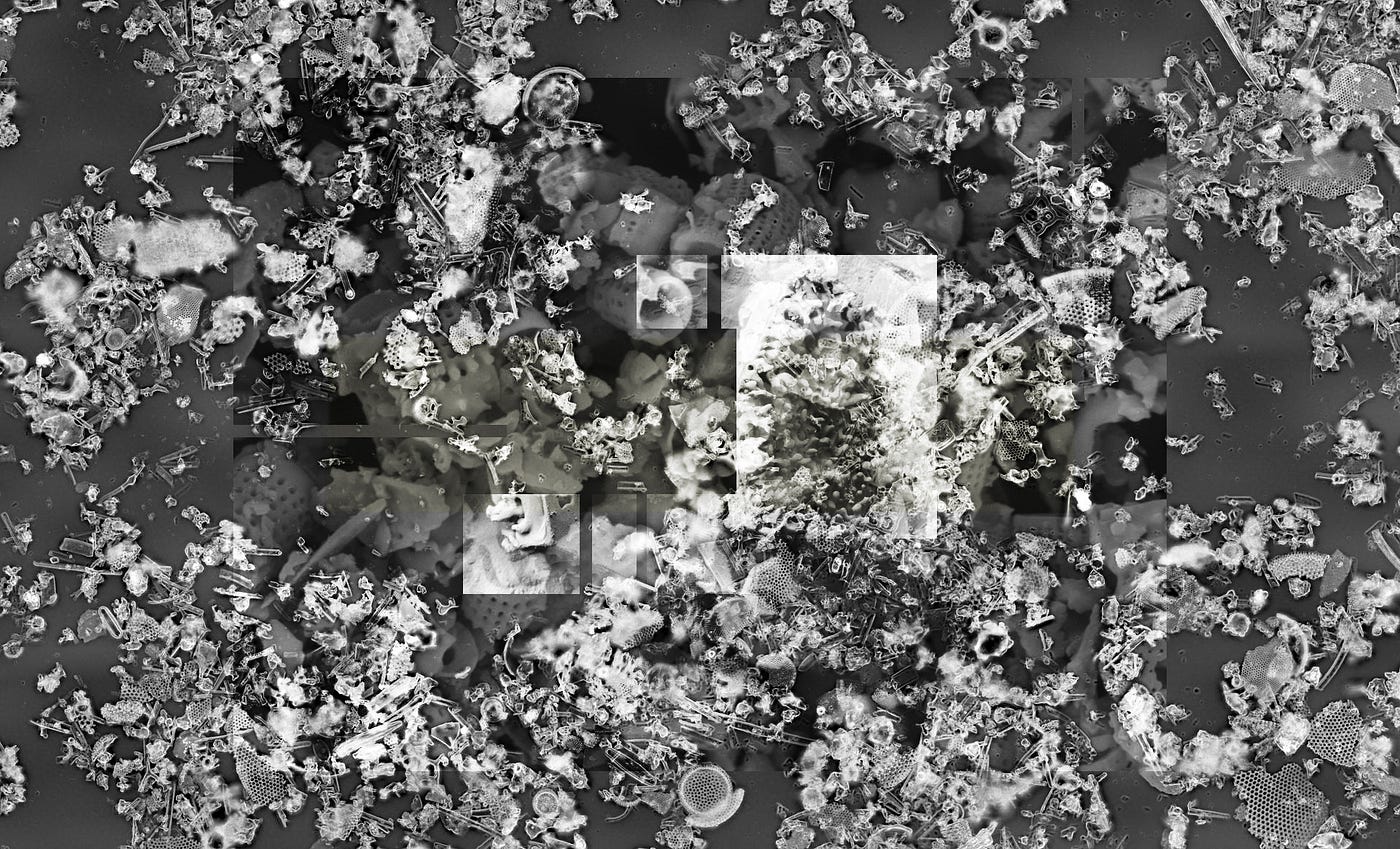
Simondon distinguishes between two types of technical objects: abstract technical objects and concrete technical objects.
Abstract technical objects are rooted in a primitive, isolated form of functionality:
… A primitive technical object is an abstract system of isolated partial ways of functioning, without common ground of existence, without reciprocal causality, without internal resonance…
(On the Mode of Existence of Technical Objects; Summary)
In this sense, abstract technical objects are straightforward and self-contained, designed to fulfill specific functions independently, without interdependence and without “internal resonance” between components.
In contrast:
… In the concrete technical object, all the functions fulfilled by the structure are positive, essential, and integrated into the functioning of the whole… Each piece, in the concrete object, is no longer simply that which essentially corresponds to the accomplishment of a function desired by the builder, but part of a system where a multitude of forces act and produce effects that are independent of the fabricating intention. The concrete technical object is a physico-chemical system in which reciprocal actions take place according to all the laws of the sciences.
(On the Mode of Existence of Technical Objects; Chapter One; emphasis mine)
A concrete technical object is described here as an integrated system in which each component operates as part of a cohesive whole, engaging in complex interactions governed by “all the laws of science,” with each element reciprocally influencing the others.
Simondon offers an example to help us differentiate between abstract technical machines and concrete ones:
One could say that the contemporary engine is a concrete engine, whereas the old engine is an abstract engine. In the old engine each element intervenes at a certain moment in the cycle, and then is expected no longer to act upon the other elements; the pieces of the engine are like people who work together, each in their own turn, but who do not know one another.
(On the Mode of Existence of Technical Objects; Chapter One)
- Old engine: The abstract engine requires separate management of each part. In this system, the components operate independently and are not interconnected; each part performs its role at a specific time without influencing the others. When we analyze the abstract engine, we see it as a collection of pieces rather than a fully integrated system.
- Contemporary Engine: The modern engine consists of various components that work together seamlessly. In this system, the parts are interdependent, with each function contributing to the overall performance. All of these components interact in a unified system, responding to changes in speed, temperature, etc.
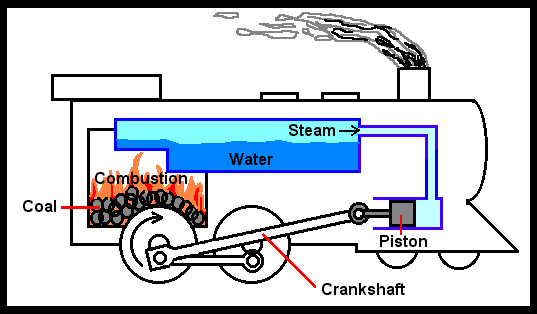
Ultimately, Simondon’s project acknowledges the evolution of technical objects and the significant role that technicity plays in shaping society and modes of production. He states:
Technicity is the degree of the object’s concretization.
(On the Mode of Existence of Technical Objects; Chapter Two)
Thus, the ultimate goal in On the Mode of Existence of Technical Objects is what Simondon calls “becoming aware”:
… The [final] phase of becoming aware, places the technical object back into the ensemble of the real, seeking to know the technical object according to its essence, according to a genesis of technicity.
(On the Mode of Existence of Technical Objects; Summary)
By highlighting the importance of this awareness, Simondon establishes a framework for understanding technical objects as interconnected elements rather than isolated entities, revealing their influence on society and modes of production. His highlighting of the genesis of technicity entails the reconsideration of the relationship between technology, society, and human experience.
Technical Machines — End
Now that we’ve done an analysis of technical machines, albeit short and not fully fleshed out, we can continue:
Thus fantasy is never individual: it is group fantasy — as institutional analysis has successfully demonstrated. (AO, 30; emphasis mine)
At this juncture, the translators make a note regarding what Deleuze and Guattari entail by institutional analysis. They write:
Institutional analysis is the more political tendency of institutional psychotherapy, begun in the late 1950s as an attempt to collectively deal with what psychoanalysis so hypocritically avoided, namely the psychoses. La Borde Clinic, established in 1955 … served as the locus for discussions on institutional psychotherapy … Felix Guattari joined the clinic in 1956, as a militant interested in the notions of desire under discussion—a topic rarely dealt with by militants at that time. Preferring the term “institutional analysis” over “institutional psychotherapy,” Guattari sought to push the movement in a more political direction, toward what he later described as a political analysis of desire… Transference came to be seen as institutional, and fantasies were seen to be collective: desire was a problem of groups and for groups.
(Translators’ note)
Without delving too deeply into Guattari’s personal life or his work at the La Borde Clinic, it’s important to recognize that, as a student of Jacques Lacan, Guattari engaged with Lacanian concepts and reinterpreted them. Within the framework of “institutional psychotherapy,” Guattari preferred the term “institutional analysis,” framing his work as a political endeavor. As a result, fantasies conceptualized by psychoanalyis were always individual; in reality, fantasies are always collective, shaped by groups.
One way to conceptualize group fantasies is through collective identities, such as ‘being a man or woman’ or ‘being an American.’ These identities are not inherent to the individual; they are constructed and maintained by groups, shaped through collective identity formations and social norms.

To continue:
And if there is such a thing as two sorts of group fantasy, it is because two different readings of this identity are possible, depending upon whether the desiring-machines are regarded from the point of view of the great gregarious masses that they form, or whether social machines are considered from the point of view of the elementary forces of desire that serve as a basis for them. (AO, 30)
Deleuze and Guattari argue that group fantasies can be examined from two different perspectives. On one hand, group fantasies are shaped by the production of ‘great gregarious masses’ through desiring-machines, and on the other hand, they are influenced by social machines, which are grounded in the ‘elementary forces of desire.’ Ultimately, both perspectives point to the same conclusion: desiring-production and social production are inseparable, functioning as two aspects of the same process.
Within group fantasy, energy may be invested in a repressive manner or a revolutionary one:
Hence in group fantasy the libido may invest all of an existing social field, including the latter’s most repressive forms; or on the contrary, it may launch a counterinvestment whereby revolutionary desire is plugged into the existing social field as a source of energy. (AO, 30)
Deleuze and Guattari use examples of different imagined socialist societies to illustrate revolutionary group fantasies.
(The great socialist Utopias of the nineteenth century function, for example, not as ideal models but as group fantasies — that is, as agents of the real productivity of desire, making it possible to disinvest the current social field, to “deinstitutionalize” it, to further the revolutionary institution of desire itself.) (AO, 30–31; emphasis mine)
When Deleuze and Guattari refer to socialist Utopias, they are alluding to the visions conceived by nineteenth-century thinkers like Charles Fourier, Robert Owen, and Claude Henri de Saint-Simon. It is crucial to recognize that these utopias — according to Deleuze and Guattari — function as ‘group fantasies’ in the sense that they reflect the collective aspirations of specific social groups rather than serving as rigid blueprints for future society.
They continue:
But there is never any difference in nature between the desiring-machines and the technical social machines. There is a certain distinction between them, but it is merely a distinction of régime,* depending on their relationships of size. Except for this difference in régime, they are the same machines, as group fantasies clearly prove. (AO, 31)
- The translators make a note about the word régime, saying that “the word régime has a number of different meanings in French, including: regimen or form of government; a set of laws, rules, or regulations; rate of flow, as of a current; rate or speed of operation, as of a motor or engine.”
Once again, it has been emphasized that there is no difference between desiring-machines and social machines. While a distinction is drawn between the two, it is based on the régime or degrees of their character rather than a fundamental separation.

Paragraph Fifteen
Deleuze and Guattari continue by reiterating the work done in the earlier paragraphs:
When in the course of our discussion above, we laid down the broad outlines of a parallelism between social production and desiring-production, in order to show that in both cases there is a strong tendency on the part of the forces of antiproduction to operate retroactively on (se rabattre sur) productive forms and appropriate them, this parallelism was in no way meant as an exhaustive description of the relationship between the two systems of production. (AO, 31)
It was seen in chapters 1.1–1.3 that the body without organs, and its antiproductive nature, falls back on (se rabat sur) the process of production and appropriates the energy found in each synthesis for itself. Deleuze and Guattari took this a step further and found that, by a phenomenological approach, there is a parallel between desiring-production and social production, but they make clear that this analysis was by no means exhaustive as…
[The parallelism] merely enables us to point to certain phenomena having to do with the difference in régime between them. (AO, 31)
One aspect that Deleuze and Guattari note is the role of technical machines (which will be further explored in the seventeenth paragraph). They elaborate:
In the first place, technical machines obviously work only if they are not out of order; they ordinarily stop working not because they break down but because they wear out. (AO, 31; emphasis mine)
As was explained in the analysis of technical machines above, Simondon discusses the various elements of what constitutes a technical object. In his 1970 interview Entretien sur la mécanologie, Simondon gives a simple explanation of the technical object that we call the ‘tool’:
Take a tool. What is essential in a tool? It is an intermediary between the body of the operator and the things on which [the operator] acts… In order to be a good tool: be unbreakable, be well-constituted.
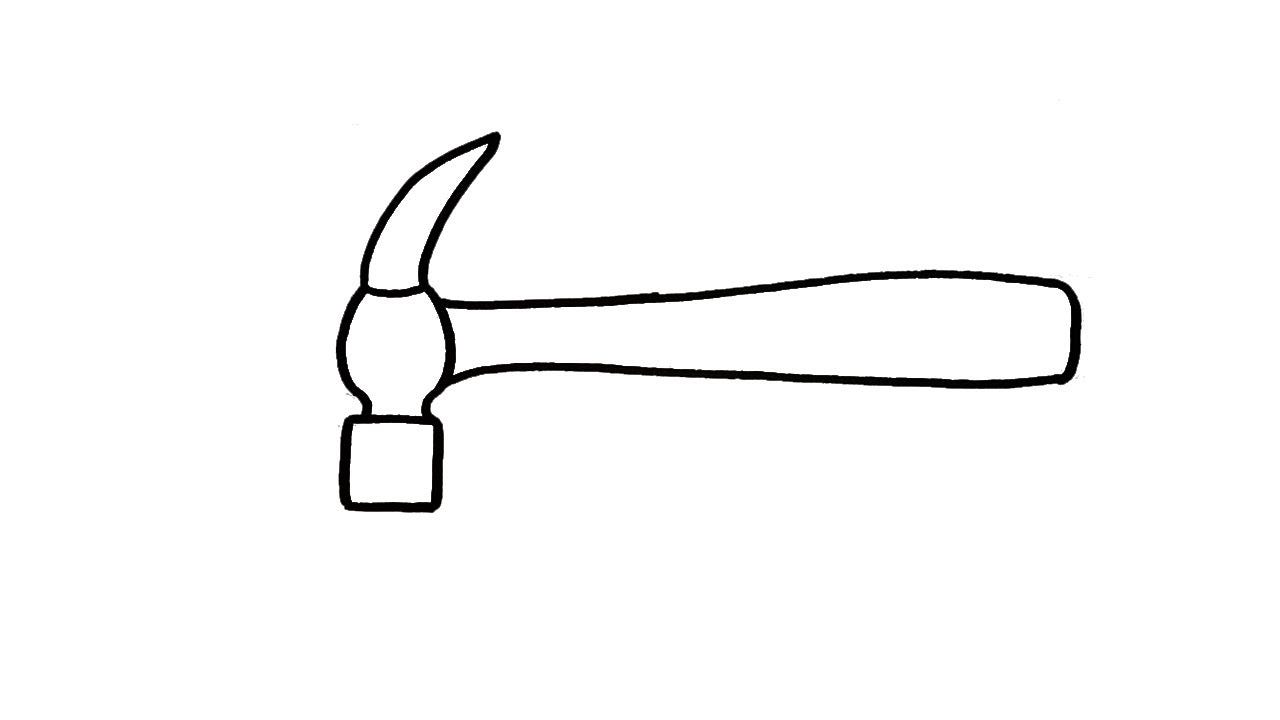
Technical machines operate by maintaining an order of arrangements within an ensemble, and akin to desiring-machines, they function through a continuous process of breaking down. In other words, they work through a process of becoming and adaptation. These breakdowns reveal the limits (and potentiality) of their current configurations, opening up possibilities for reconfiguration. However, they do stop working under the condition of their deterioriation or their ‘wearing out.’
Marx also notes this fact and incorporates it into his analysis of the production process:
Marx makes use of this simple principle to show that the régime of technical machines is characterized by a strict distinction between the means of production and the product; thanks to this distinction, the machine transmits value to the product, but only the value that the machine itself loses as it wears out. (AO, 31)
Marx makes a strategic move where he isolates that a technical machine does not add intrinsic value to the product it produces — at least in the sense of “creating” value; rather, a technical machine simply transfers value to the product as the technical machine wears down. The product’s value is dependent on the depreciation of the machine that produces it.
On the contrary, desiring-machines don’t transfer value to a product as the product always remains an “offshoot of production”:
Desiring-machines, on the contrary, continually break down as they run, and in fact run only when they are not functioning properly: the product is always an offshoot of production, implanting itself upon it like a graft, and at the same time the parts of the machine are the fuel that makes it run. (AO, 31)
Unlike technical machines, desiring-machines only function through wearing out or “not functioning properly.” While technical machines operate by breaking down, they only continue to work as long as they are not wearing out; they transfer value to the product through their deterioration, until they eventually dissolve. In contrast, desiring-machines work through their breakdowns, or more precisely, through their wearing out, where the product emerges within the ongoing process of production, alongside desiring-machines.
— —
Consider this example to sum up our progression: If someone works at a shoe factory and operates a technical shoe machine, the shoe machine will gradually wear down over time as it produces shoes, and transfers its value to the shoes, leading to its eventual dissolution. However, the machine remains functional as long as it is in working order and undergoing breakdowns. It is only once the machine has fully worn out that it ceases to function.
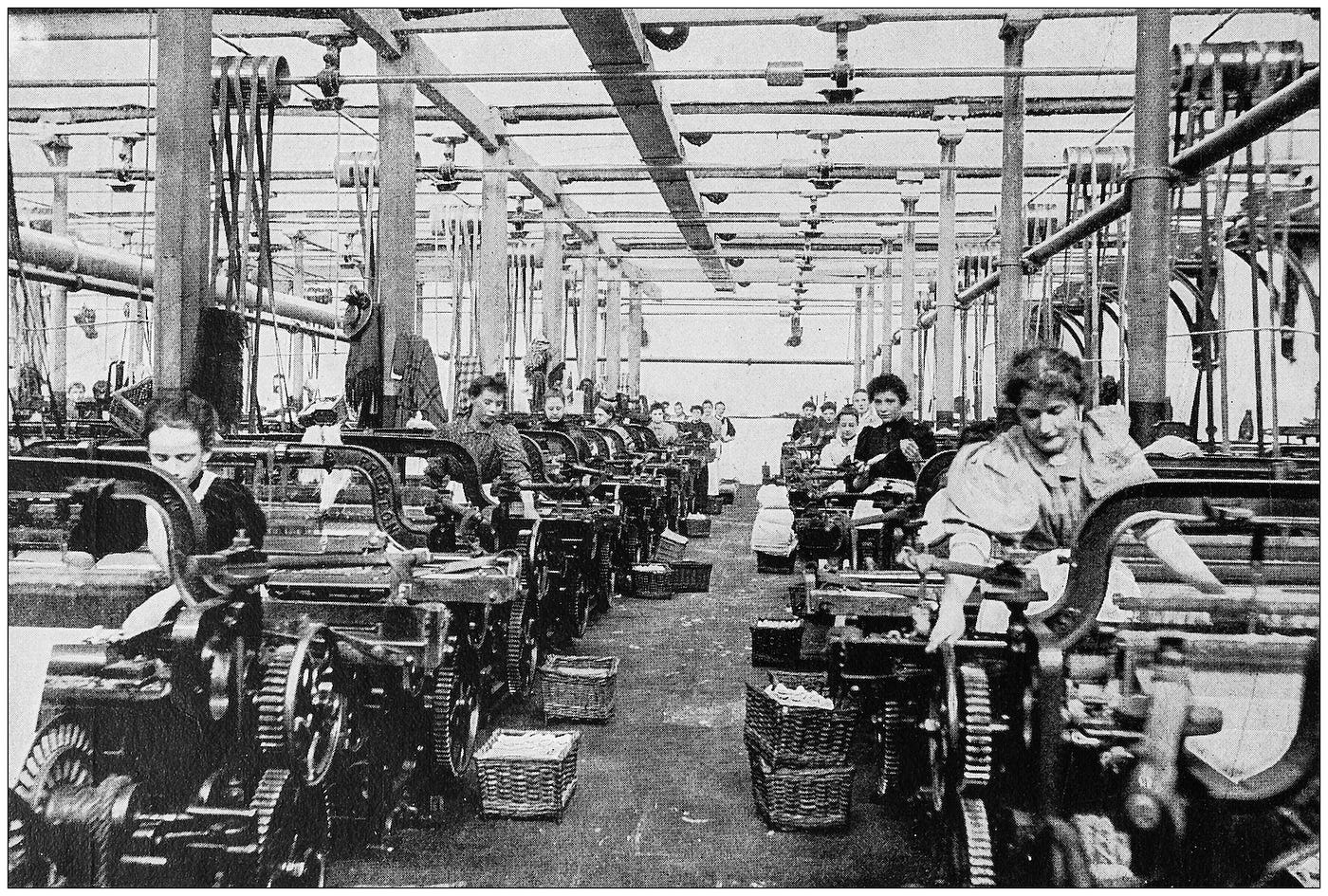
Paragraph Sixteen
Deleuze and Guattari begin by discussing artistry:
Art often takes advantage of this property of desiring-machines by creating veritable group fantasies in which desiring-production is used to short-circuit social production, and to interfere with the reproductive function of technical machines by introducing an element of dysfunction. (AO, 31)
Art creates collective fantasies that resonate beyond individuals, influencing society as a whole. Art, consumed in a raw and unregulated way, bypasses the norms of social production. Unlike technical machines, which transfer value to their products through their ‘wearing out’, art is produced alongside desiring-machines, disrupting technical machines and social machines, serving as “an element of dysfunction.” Now, none of this assumes that art cannot be commodified by capitalism; Deleuze and Guattari are solely analyzing how art can short-circuit social production. We will eventually learn that art can simultaneously be plugged back into social production.
Deleuze and Guattari give examples of artists and their work that exemplify art taking advantage of the process of desiring-production:
Arman’s charred violins, for instance, or Cesar’s compressed car bodies. More generally, Dali’s method of critical paranoia assures the explosion of a desiring-machine within an object of social production. (AO, 31)
The emphasis on Dali’s “critical paranoia” seems to be Deleuze and Guattari praising Dali for successfully harnessing and intensifying desiring-production in such a manner that disrupts social norms, figures, bodies, and established normative perceptions. By deliberately blurring the boundaries between reality and fantasy, allowing them to collapse upon one another, the unconscious is deemed as part of the production process.
The artworks in the next three figures show the dysfunction of an everyday object like a violin, car, and watch:
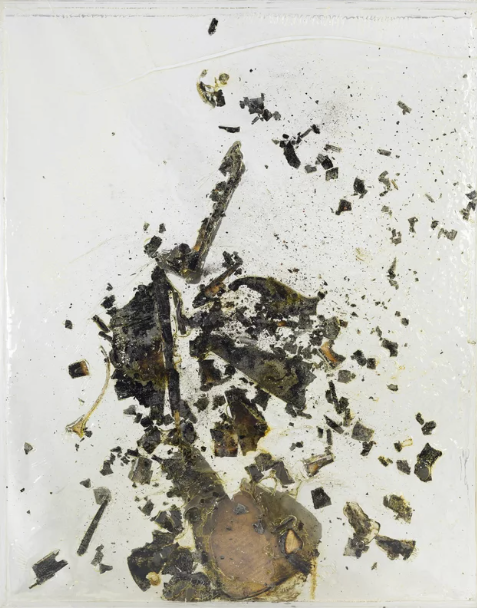
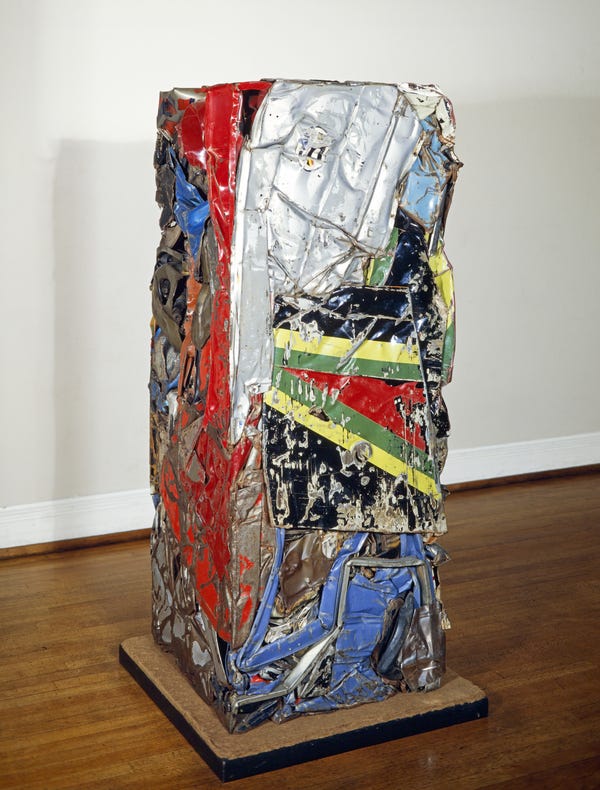
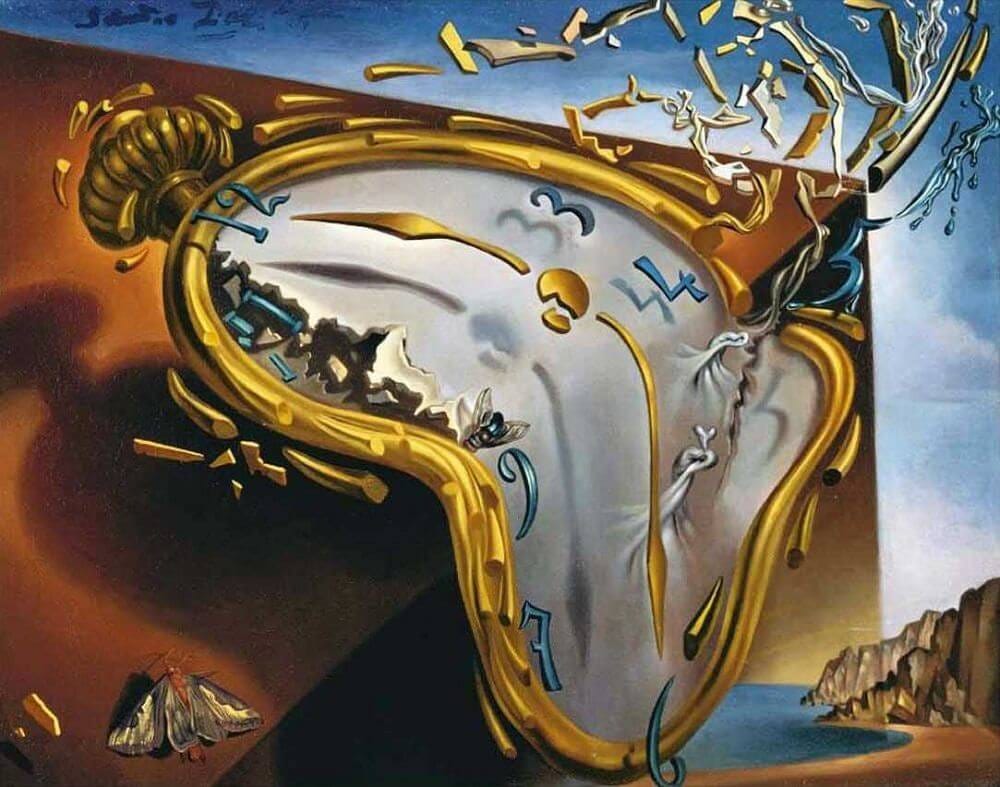
Deleuze and Guattari continue by discussing French composer and pianist Maurice Ravel and his music-machines:
But even earlier, Ravel preferred to throw his inventions entirely out of gear rather than let them simply run down, and chose to end his compositions with abrupt breaks, hesitations, tremolos, discordant notes, and unresolved chords, rather than allowing them to slowly wind down to a close or gradually die away into silence. (AO, 31–32)
- Deleuze and Guattari cite Vladimir Jankélévitch’s book Ravel published in 1959.
Ravel’s Une Barque sur l’Océan is one of my favorite pieces. It truly captures the feeling of a boat drifting on the ocean (hence its name). You can listen to it here. I also highly recommend Ravel’s Boléro — a must-hear piece of music. Listen to it here.
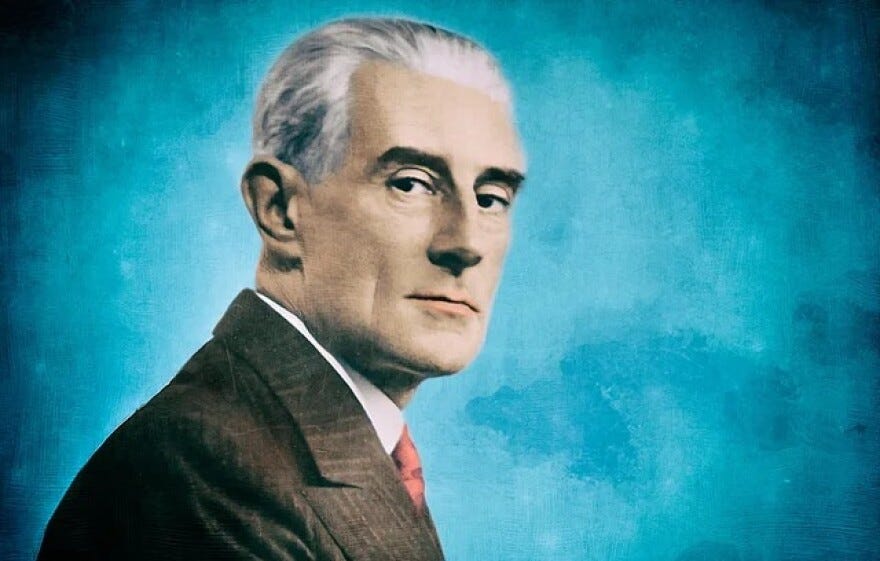
So … what is the artist?
The artist is the master of objects; he puts before us shattered, burned, broken-down objects, converting them to the régime of desiring-machines, breaking down is part of the very functioning of desiring-machines; the artist presents paranoiac machines, miraculating-machines, and celibate machines as so many technical machines, so as to cause desiring-machines to undermine technical machines. (AO, 32)
Deleuze and Guattari emphasize the signifiance of the artist’s unconventional nature, using “broken-down objects” as a key element. They associate this breakdown with the functioning of desiring-machines; they argue that the machines found in the second and third syntheses of unconscious are portrayed as technical machines, suggesting that art breaks down the technical machines of desiring-production while simultaneously interfering with their reproduction at the level of social production. Thus, Deleuze and Guattari sum up and conclude:
Even more important, the work of art is itself a desiring-machine. The artist stores up his treasures so as to create an immediate explosion, and that is why, to his way of thinking, destructions can never take place as rapidly as they ought to. (AO, 32; emphasis mine)
This depiction of art being a desiring-machine fully captures the idea that artistry short-circuits social production by adding various elements of dysfunction that explode upon the medium by which the art is being conveyed and produced.
Paragraph Seventeen
As a reminder from above, the first difference in régime between desiring-machines and technical social machines is:
… Technical machines obviously work only if they are not out of order; they ordinarily stop working not because they break down but because they wear out. (AO, 31)
- As described above, and as Simondon observes with the technical object, technical machines must function properly in order to transmit value to a product. Through this transmission of value, the machine undergoes wear and tear, leading to its dissolution. Whereas desiring-machines, like music, are not transmitting value to a product because the product is being grafted upon the production process. (What is the product present as you are listening to a song?)
Deleuze and Guattari continue the seventeenth paragraph by explaining the second difference in régime:
From this, a second difference in régime results: desiring-machines produce antiproduction all by themselves, whereas the antiproduction characteristic of technical machines takes place only within the extrinsic conditions of the reproduction of the process (even though these conditions do not come into being at some “later stage”). (AO, 32)
In the three syntheses of the unconscious, we see the antiproductive nature of the body without organs fall back on the process of production, appropriating the surplus energy of desiring-production for itself. This results in desiring-machines producing antiproduction through their interactions upon the body without organs. However, technical machines do not produce antiproduction on their own. Instead, their antiproduction arises within the “extrinsic conditions of the reproduction of the process.” In simpler terms, technical machines must refer back to a socius or social machine. Deleuze and Guattari write:
That is why technical machines are not an economic category, and always refer back to a socius or a social machine that is quite distinct from these machines, and that conditions this reproduction.
(AO, 32; emphasis mine)
Here is where we finally get a clear definition of technical machines and their correlative to various socii (socii is the plural form “socius”):
A technical machine is therefore not a cause but merely an index of a general form of social production: thus there are manual machines and primitive societies, hydraulic machines and “Asiatic” forms of society, industrial machines and capitalism. (AO, 32)
Let us review each machine and their correlative socius:
- Manual machines refer to the devices developed in early societies, from the Paleolithic and Neolithic eras and some continuing eras thereafter. These machines are simple and what Simondon described as abstract technical objects. These devices rely on human labor for operation, rather than external energy sources such as water or steam.


- Hydraulic machines refer to devices developed by “Asiatic” societies that use liquid (specifically water) to perform processes. These machines were common in early industrial processes serving an important role in irrigation and milling. For example, ancient Greece and Rome particularly had sophisticated hydraulic machines like those of watermills and were pioneers in hydraulic engineering. Other significant hydraulic machines were chain pumps, like those developed in ancient China. Even though chain pumps require some amount of labor, it makes the process much more efficient as the pump moves water upwards without requiring constant manual labor.

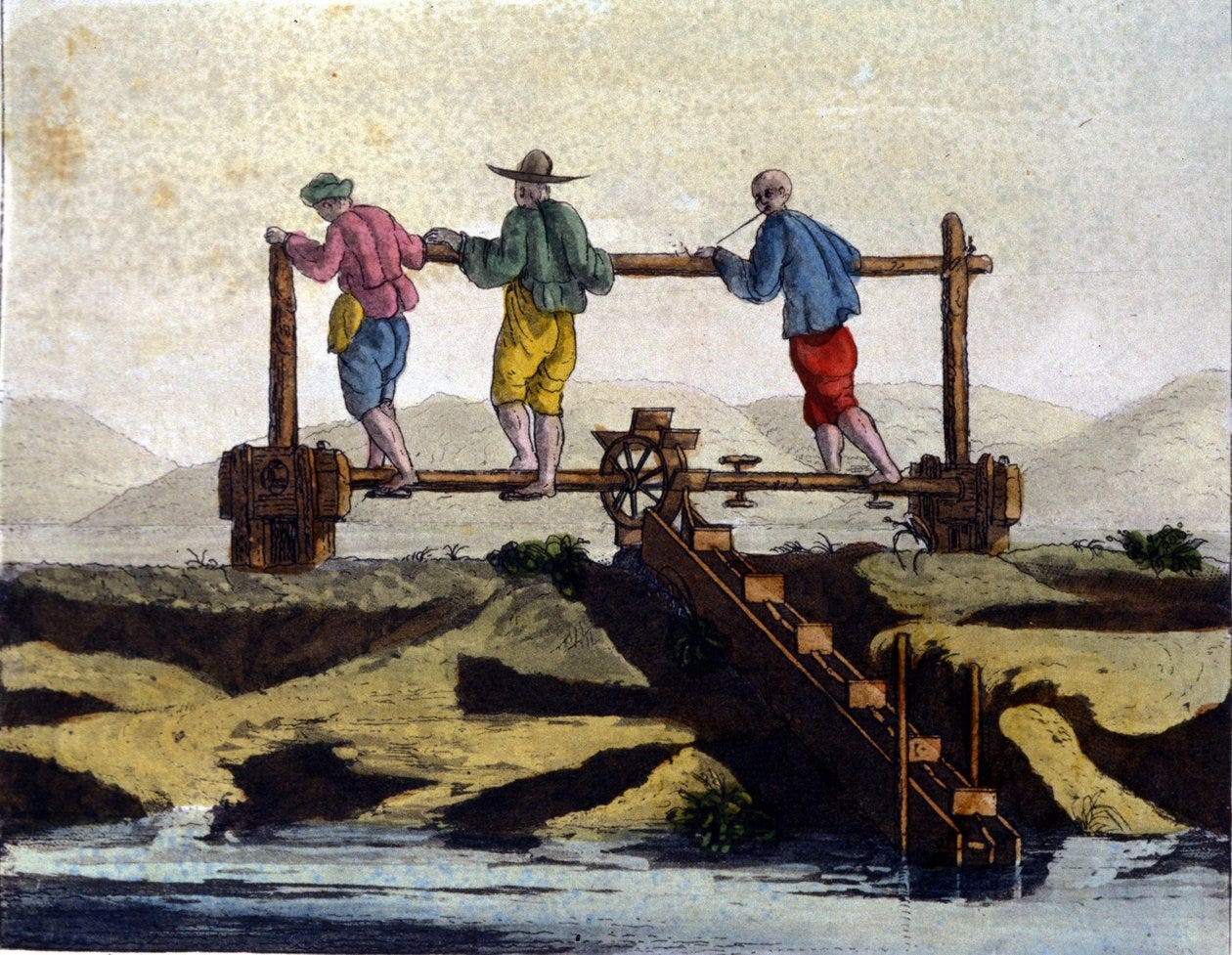
- Industrial machines refer to devices developed by capitalist societies in order to increase capitalist production; these devices can look like factories, tools, and engines that contribute to the production, distribution, and consumption of commodities. These machines produce goods in a structured fashion. A specific example that comes to mind is Henry Ford’s moving assembly line as seen in Figure Sixty-Three.
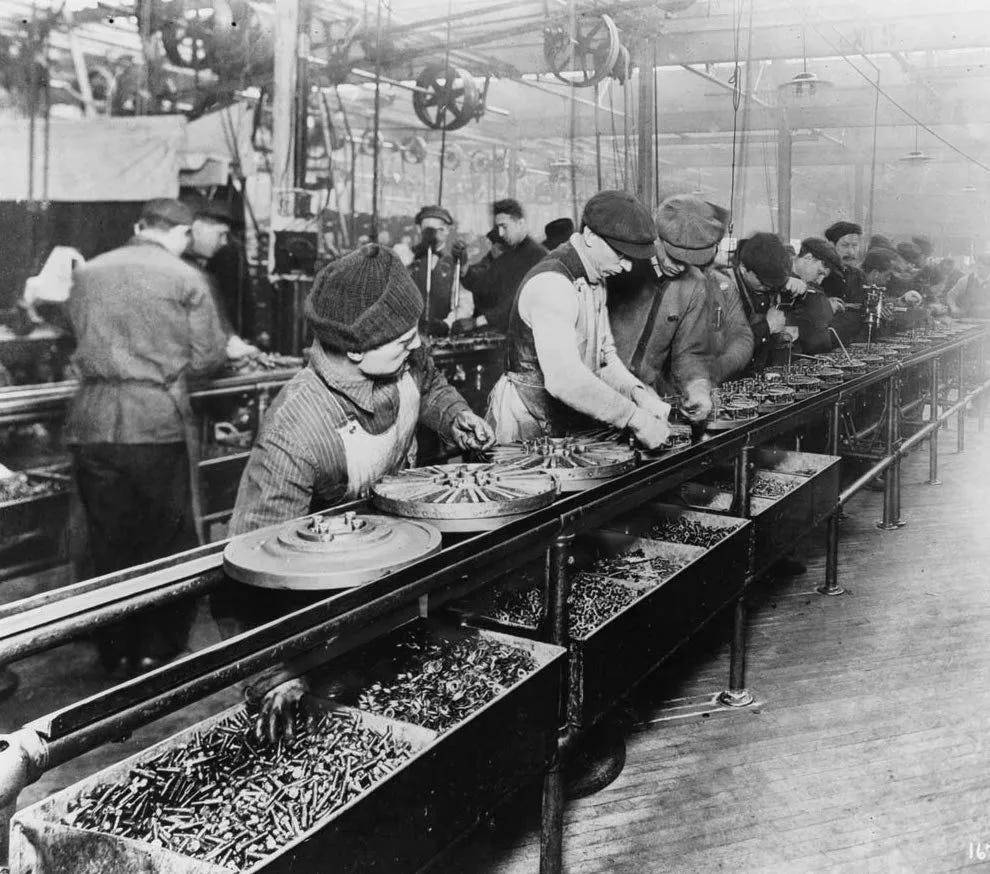

It is important to note that Deleuze and Guattari are not suggesting manual machines are absent in “Asiatic” or capitalist societies, nor that hydraulic machines are exclusive to “Asiatic” societies. In fact, many machines can appear to be of a specific kind depending on the perspective from which they are viewed. For example, the Archimedes screw, commonly used for raising water in irrigation systems in ancient Greece, requires some level of manual labor for its operation, but at the same time, it can also function only using flowing water. So … is it a manual machine or a hydraulic one? These distinctions are largely irrelevant. Deleuze and Guattari’s primary concern is not with rigid classifications of machines, but rather with which types of machines dominate the socius at a given time, shaping production and social organization.
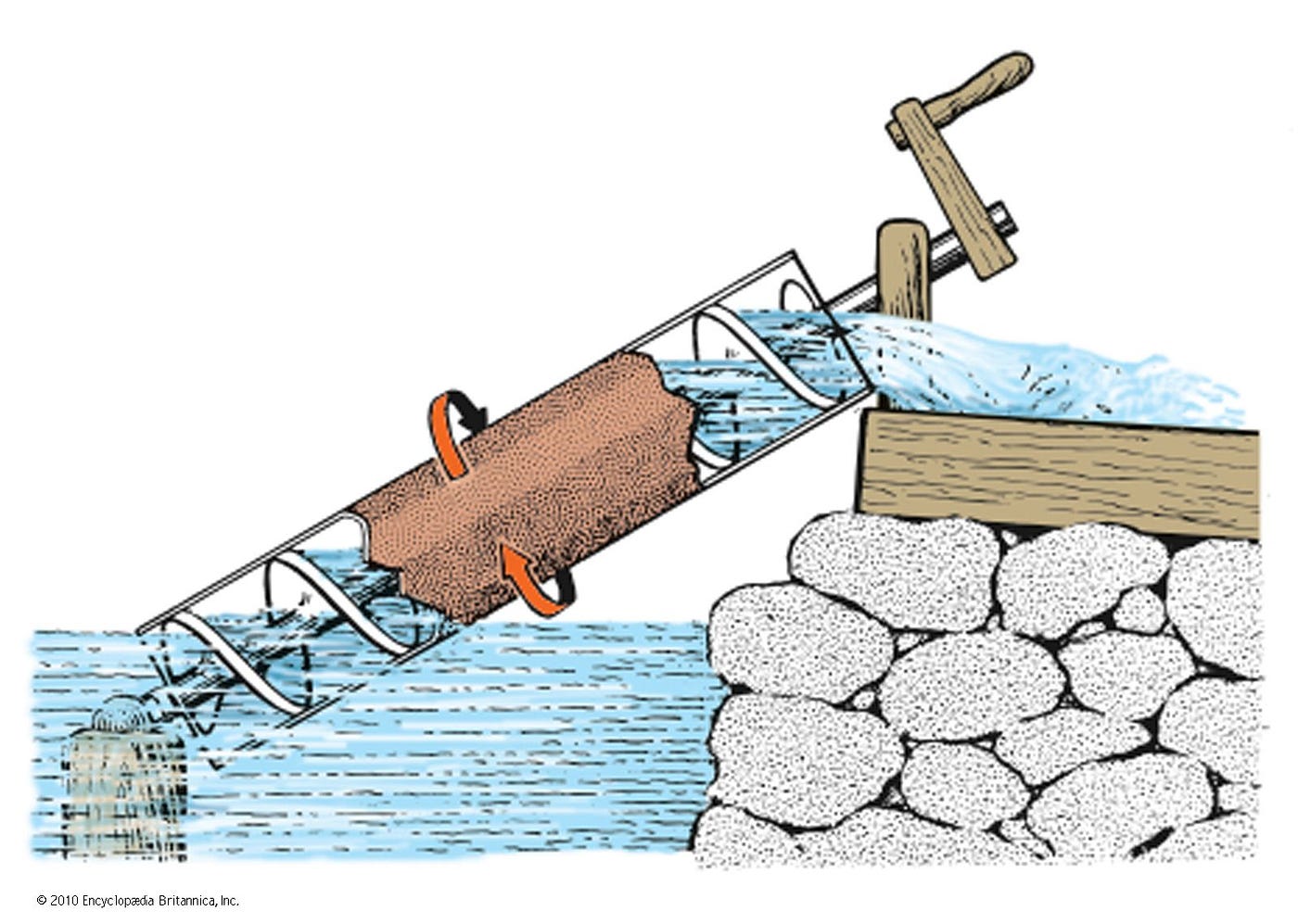
As we have outlined the second distinction in régime between desiring-machines and technical machines (with the technical machines being indexical to their corresponding socius), Deleuze and Guattari emphasize that while desiring-production and social production are the same with two differences in régime, there remains a crucial distinction:
Hence when we posited the socius as the analogue of a full body without organs, there was nonetheless one important difference. (AO, 32)
To grasp this crucial difference between desiring-machines and the socius, Deleuze and Guattari first explain that desiring-machines make no distinctions between anything:
For desiring-machines are the fundamental category of the economy of desire; they produce a body without organs all by themselves, and make no distinction between agents and their own parts, or between the relations of production and their own relations, or between the social order and technology. (AO, 32)
From the standpoint of desiring-machines, everything is interconnected through various emissions and interruptions of flows that pass through them; unlike social production, desiring-production finds that there is no distinction between the socius and technical machines that are produced externally by them. Similarly, there is no distinction between an agent and the parts that make up that agent. Thus:
Desiring-machines are both technical and social. (AO, 32)
Therefore, the fundamental distinction between desiring-production and social production lies in where repression takes place:
It is in this sense that desiring-production is the locus of a primal psychic repression*, whereas social production is where social repression takes place, and it is between the former and the latter that there occurs something that resembles secondary psychic repression in the “strictest” sense: the situation of the body without organs or its equivalent is the crucial factor here, depending on whether it is the result of an internal process or of an extrinsic condition (and thus affects the role of the death instinct in particular).
(AO, 32; emphasis mine)
*The translators note that Deleuze and Guattari appear to be drawing from the 1967 book The Language of Psychoanalysis published by French psychoanalysts Jean Laplanche and Jean-Bertrand Pontalis (though quite odd, the translators refer to the 1974 English translation in their footnote). Deleuze and Guattari are referring to Laplanche and Pontalis’ work when they speak of the tension between psychic repression and social repressing producing something that resembles secondary psychic repression in the “strictest” sense. Here is a quote from The Language of Psychoanalysis that I find fitting for this specific passage:
1967 French Translation: Le refoulement proprement dit (eigentliche Verdrängung) ou « refoulement après coup » (Nachdrängen) est donc un processus double, alliant à cette attraction une répulsion (Abstossung) de la part d’une instance supérieure.
1974 English Translation: This ‘primal repression’ determines repression in the strict sense of the term, which is only made possible by the concerted action, upon the elements destined to be repressed, of a force of repulsion exerted by a higher agency and an attraction exerted by what has already been fixated.
It is crucial to note that Deleuze and Guattari are drawing on the work of Laplanche and Pontalis in developing their project. As we will see in the following analysis, Deleuze and Guattari are meticulous in their choice of terms, such as using “refoulement originaire” instead of “refoulement primaire,” as specifically pointed out by the translators.

To understand Deleuze and Guattari’s argument, we must first understand how Freud conceptualizes primary and secondary repression. In simple terms, Freud saw primary repression as a foundational mechanism that blocks unconscious desires from reaching conscious awareness. Once this primary repression is in place, it sets the stage for the mind to repress new, conscious thoughts or feelings as they arise. For example, if a child experiences sexual curiosity by touching their genitals and is told that such feelings and actions are ‘shameful’ or ‘bad,’ that impulse is repressed and kept out of conscious awareness (primary repression), meaning the child is unable to fully acknowledge the desire due to the external prohibition. Later in life, when this person, now an adult, experiences sexual arousal, they may also feel guilt as a result of this early repression (secondary repression). Thus, for Freud, the guilt associated with sexual arousal is the outcome of a secondary repression arising from a foundational primary repression.
In contrast to Freud, who suggests that secondary repression arises when repressed thoughts resurface on top of a pre-established primary repression, Deleuze and Guattari argue that repression is always primal and in the context of the paranoiac-machine. When psychoanalysis speaks of primary repression, they are really only speaking of paranoiac-machines. The term “primary repression” suggests a type of succession that Deleuze and Guattari are cautious of, while the word “primal” is much better as it enables us to conceptualize repression at the level of machines without succession. Deleuze and Guattari argue that it is not the ‘return of repressed’ impulses that leads to a secondary repression, but rather the tension between desiring-production (psychic repression) and social production (social repression) which creates something that resembles secondary repression.
According to the three syntheses, if the subject is continually recreated, then how could secondary repression even exist? Everything is fundamentally produced primarily as in primal; nothing can be secondary. In the second synthesis, paranoiac-machine functions as “primal repression,” repelling desiring-machines. This repulsion suspends connections between machines. Simultaneously, a miraculating-machine functions to attract desiring-machines back to the surface of the body without organs. For example, a mouth-machine disconnects from a breast-machine, connect to another machine, and then disconnect from that machine, initiating a series of re-couplings. Then, in the third synthesis, the “celibate machine” functions as a form of “return of the repressed,” reconciling the tension between paranoiac and miraculating machines and banding these intensities produced by the paranoiac and miraculating-machines into a consumable quantity for the subject (see Chapter 1.3, Paragraph One).
All of this may seem to suggest a secondary repression following a primary one (as the third synthesis comes after the second synthesis) but Deleuze and Guattari’s framework does not support the idea of re-repressing previously repressed material — it only resembles a secondary repression. It’s important to remember that the three syntheses are simply three perspectives of the same process: production is immediately distribution is immediately consumption. And then … the entire process starts up again.
To put simply, a subject is reborn with each state that they consume: a mouth-machine disconnects from a breast-machine and turns into a vomiting-machine; a hand-machine is swatted away from a genital-machine; an eye-machine connects to a pornography-machine; an adult encounters an infidelity-machine; a person is subjected to the moral judgements of a religious-machine. All of these experiences produce the the subject without reawakening buried impulses — repression is immanently produced upon the body without organs. Deleuze and Guattari emphasize that whatever resembles a secondary repression results from the continuous interaction between psychic repression and social repression (but this doesn’t constitute repression as secondary). Repression is not merely rooted in childhood prohibitions, such as hearing that sex is “shameful”; it’s about the ongoing interaction between psychic and social repression, all unfolding on the body without organs.
And finally, the death instinct mentioned here refers to the drive toward destruction, which emerges from the interplay between desiring-production and social production. Earlier, we explored how death is something that desire desires — but not in a negative sense. However, the role of death changes depending on the specific relationship between the body without organs and what resembles secondary psychic repression. Whether the repression stems from an internal process or an external one shifts the nature of this death drive from a positive, productive force into a destructive one.
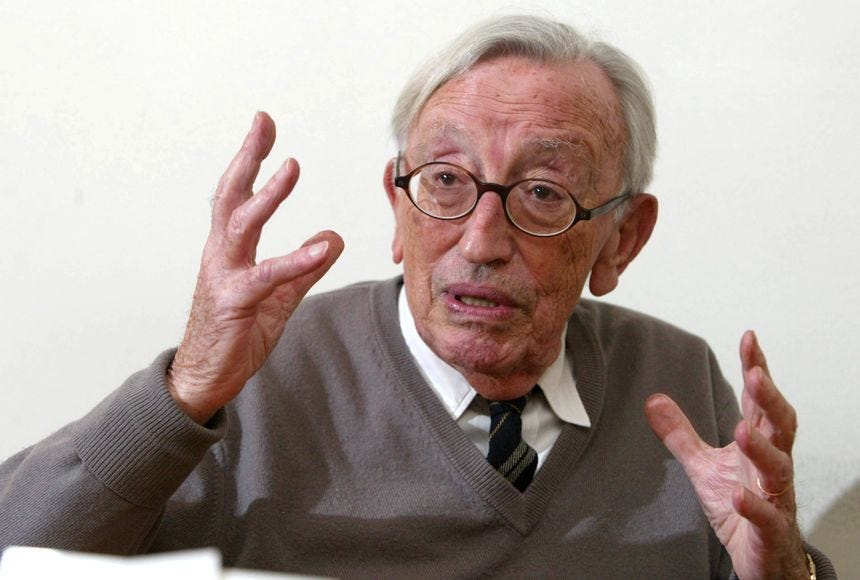
Paragraph Eighteen
Deleuze and Guattari, as is evident by now, reaffirm their earlier thesis:
But at the same time [desiring-machines and technical social machines] are the same machines, despite the fact that they are governed by two different régimes — and despite the fact that it is admittedly a strange adventure for desire to desire repression. (AO, 32)
It’s important to note that this marks the first time Deleuze and Guattari explicitly states that desire desires its own repression. While it was evident that they find repression to be a counterproduct or countereffect of desire, here they clarify that the key issue lies in the fact that desire itself seeks its own repression. However, this “strange” fact does not alter the fundamental idea that desiring-machines and technical social machines operate as one and the same. Furthermore:
There is only one kind of production, the production of the real. (AO, 32; emphasis mine)
…
And doubtless we can express this identity in two different ways, even though these two ways together constitute the autoproduction of the unconscious as a cycle. (AO, 32–33; emphasis mine)
- “This identity” is the shared unified essence of production in both desiring-production and social production.
All they are saying is that the production of the real can be expressed in two manners (desiring-production and social production).
To sum up this progression, Deleuze and Guattari state:
We can say that social production, under determinate conditions, derives primarily from desiring-production: which is to say that Homo natura comes first. But we must also say, more accurately, that desiring-production is first and foremost social in nature, and tends to free itself only at the end: which is to say that Homo historia comes first. (AO, 33)
The term “homo natura” references 19th-century philosopher Friedrich Nietzsche’s 1886 work Beyond Good and Evil. In section 230 of Beyond Good and Evil, Nietzsche discusses the artificial separation between humanity and nature. Ironically, he likens a human detached from nature to Oedipus, who, in the Greek tragedy Oedipus Rex, blinds himself at the story’s end. Nietzsche writes:
For to translate man back into nature; to master the many vain and fanciful interpretations and secondary meanings which have been hitherto scribbled and daubed over that eternal basic text homo natura; to confront man henceforth with man in the way in which, hardened by the discipline of science, man today confronts the rest of nature, with dauntless Oedipus eyes and stopped‐up Odysseus ears…
(Beyond Good and Evil; Section 230; emphasis mine)
In this manner, Deleuze and Guattari state that because desiring-production produces social production, from one perspective nature comes first; from yet another perspective, desiring-production is naturally social, therefore history (or the social) comes first. Once again, the distinction is an arbitrary one, only different in terms of régime.
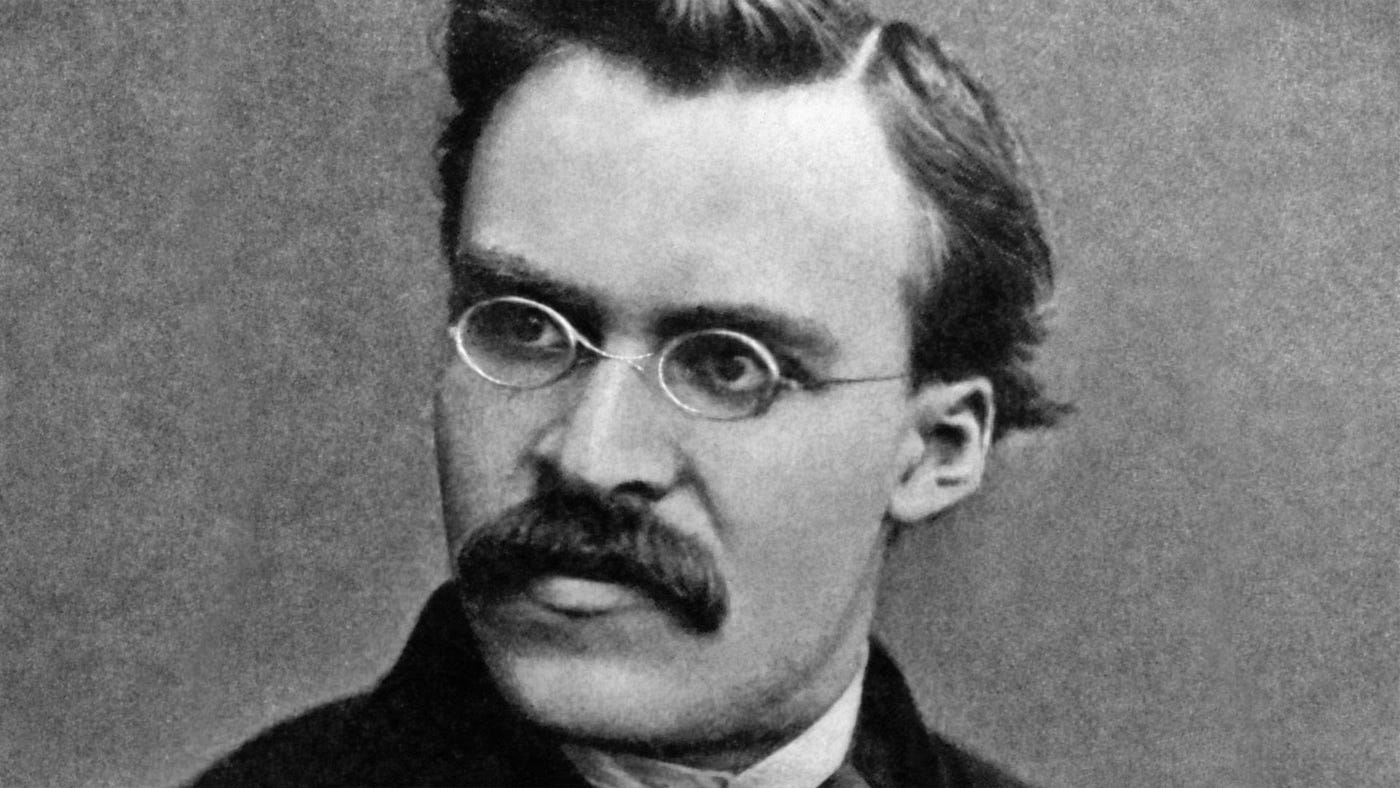
They continue:
The body without organs is not an original primordial entity that later projects itself into different sorts of socius, as though it were a raving paranoiac, the chieftain of the primitive horde, who was initially responsible for social organization. (AO, 33)
Deleuze and Guattari explicitly state that the body without organs should not be seen as the origin of the socius. Instead, the socius is formed through social production recording points on the surface of the socius. It seems that Deleuze and Guattari as pointing to the socius as having a seemingly divine or almost mystical presence (similar to Marx’s commodity fetishism); however, they are clear that this is not a question of projection by the body without organs. They continue by describing the three socii:
The social machine or socius may be the body of the Earth, the body of the Despot, the body of Money. (AO, 33)
Deleuze and Guattari isolate the three socii found in Chapter Three: the primitive socius (the body of the Earth), the despotic socius (the body of the Despot), and the capitalist socius (the body of Money). Yet, the socii are not a projection of the body without organs:
It is never a projection, however, of the body without organs. On the contrary: the body without organs is the ultimate residuum of a deterritorialized socius. (AO, 33; emphasis mine)
This is the first time that Deleuze and Guattari mention the important concept of deterritorialization (albeit in an abrupt manner). The concepts of territorialization, deterritorialization, and reterritorialization will play a large role throughout Anti-Oedipus, but we will not go in-depth with these concepts until they arise more prominently throughout the book. For now, and by what we can deduce, a territory refers to a space that is controlled and regulated while the concept of deterritorialization involves the breaking down and disruption of the boundaries that constitute the territory. Thus, as stated above and throughout Chapter 1.1–1.3, the body without organs is a residuum. The body without organs is produced by the syntheses while serving as a fundamental foundation for the syntheses operation. In the case of the socius, the body without organs emerges as the ultimate residuum — a surface upon which social production inscribes points onto.
We must ask what the function of the socius is:
The prime function incumbent upon the socius, has always been to codify the flows of desire, to inscribe them, to record them, to see to it that no flow exists that is not properly dammed up, channeled, regulated.
(AO, 33)
The primary role the social production in relation to the socius has always been to codify, inscribe, and regulate the flows of desire. This ensures that no flow remains uncontrolled or unchanneled. According to Deleuze and Guattari, the socius functions as a surface that governs all desire, leaving no flow unregulated or without boundaries; desire becomes regulated and mapped out into a charted territory.

Deleuze and Guattari highlight the various socii and their evolution:
When the primitive territorial machine proved inadequate to the task, the despotic machine set up a kind of overcoding system. But the capitalist machine, insofar as it was built on the ruins of a despotic State more or less far removed in time, finds itself in a totally new situation: it is faced with the task of decoding and deterritorializing the flows.
(AO, 33; emphasis mine)
Though more of this will be in Chapter Three, Deleuze and Guattari note that the primitive socius was overtaken by the despotic socius and the despotic socius was overtaken by the “capitalist machine” (the capitalist socius). The analysis in Chapter Three will cover the specifics of the primitive socius and the despotic system of overcoding (which is extremely different than decoding). For now, let us focus on capitalism. Capitalism, unlike the primitive and despotic socius, does something radical. Instead of coding, channeling, and regulating the flows of desire tightly, capitalism decodes and deterritorializes the flows of desire.
Deleuze and Guattari are concerned with how the capitalist socius regulates flows of desire:
Capitalism does not confront this situation from the outside, since it experiences it as the very fabric of its existence, as both its primary determinant and its fundamental raw material, its form and its function, and deliberately perpetuates it, in all its violence, with all the powers at its command. Its sovereign production and repression can be achieved in no other way. (AO, 33)
The deterritorialization of the flows of desire constitutes the “fabric of [capitalism’s] existence.” What is important here is that capitalism can function in no other manner except deterritorialization.

But what does this all mean? There is a discussion about decoding and deterritorializing, but what does this look like? Thankfully, Deleuze and Guattari highlight the decoded flows that capitalism is born from:
Capitalism is in fact born of the encounter of two sorts of flows: the decoded flows of production in the form of money-capital, and the decoded flows of labor in the form of the “free worker.”
(AO, 33; emphasis mine)
Firstly, instead of applying fixed codes found in earlier societies, capitalism decodes flows of production by using money as a universal stand-in across the production process. This decoding of production allows for diverse types of labor, goods, and services to be unified under a single, universally applicable measure: money. Unlike barter and traditional trade, money circulates across industries and borders as a purely quantitive measure of worth, untethered from any specific cultural or local meaning.
Secondly, instead of fixing labor in place through social codes, capitalism decodes labor in order to make it universally exchangeable. Decoding labor implies eradicating fixed, local meaning tied to work and labor, allowing workers to move freely from one space to the next in order to sell their labor. This enables labor itself to become a commodity, something that can be bought and sold like any other good, based on supply and demand rather than traditional roles or relationships.
Capitalism only decodes flows; therefore, it differs from all previous socii:
Hence, unlike previous social machines, the capitalist machine is incapable of providing a code that will apply to the whole of the social field. (AO, 33)

Deleuze and Guattari continue to discuss the concept of axiomatics:
By substituting money for the very notion of a code, it has created an axiomatic of abstract quantities that keeps moving further and further in the direction of the deterritorialization of the socius. (AO, 33)
Again, as production is decoded into money — with capitalism substituting money for code — money becomes an “axiomatic” in capitalist society. Money organizes production not according to specific codes pertaining to social values or needs, but through abstract quantities. This means that money is no longer merely a medium of exchange; money becomes a universal measure of value that operates beyond particular social relations. Instead of being tied to specific cultural or social contexts, money quantifies everything, reducing good, services, labor, and even social practices into calculable units.
Everything from labor to leisure has a price: a loaf of bread costs $4, an hour of labor costs $7.25, and a work of art can be valued at $1,000,000. These prices are determined by market forces, based on supply, demand, and other economic factors. Even if something has sentimental value or personal meaning, the capitalist socius has a way of assigning it a market price through the decoding of production into what we call ‘money.’ Life itself is framed within a cost structure — hence the term “cost of living.”
Deleuze and Guattari continue by describing the ultimate nature of capitalism:
Capitalism tends toward a threshold of decoding that will destroy the socius in order to make it a body without organs and unleash the flows of desire on this body as a deterritorialized field. (AO, 33)
When they refer to capitalism “destroying the socius,” they are describing how capitalism decodes and deterritorializes flows, seemingly disorganizing flows in a way that produces the body without organs (the body without organs refuses to become organized, so capitalism’s decoding of flows is in line with the production of the body without organs; and, as described in Chapter 1.2, capital is a body without organs for the capitalist figure). However, capitalism is always only pushing towards this threshold rather than surpassing it; capitalism tends towards this threshold but always functions within the limit of capital. Capitalism cannot transcend the limit of capital because it is bound by the limit of capital. (This understanding of interior and exterior limit of capitalism will further be explored in Chapter Three).

What’s crucial to note (and the main takeaway from this quote) is that capitalism attempts to break down the regulated flows of desire. In this way, capitalism tending towards a schizophrenic limit breaks down the regulated flows of desire. Deleuze and Guattari finally conclude this paragraph with a question regarding the relationship between schizophrenia and capitalism:
Is it correct to say that in this sense schizophrenia is the product of the capitalist machine, as manic-depression and paranoia are the product of the despotic machine, and hysteria the product of the territorial machine?* (AO, 33)
*Deleuze and Guattari have a footnote here where they elaborate on the question of madness in relation to social structures:
“On hysteria, schizophrenia, and their relationships with social structures, see the analyses by Georges Devereux in his Essais d’ethnopsychiatrie generale … and the wonderful pages in Karl Jaspers’ Strindberg und Van Gogh … The question has been asked: is madness in our time “a state of total sincerity, in areas where in less chaotic times one would have been capable of honest experience and expression without it?” Jaspers reformulates this question by adding: ”We have seen that in former times human beings attempted to drive themselves into hysteria; and we might say that today many human beings attempt to drive themselves into madness in much the same way. But if the former attempt was to a certain extent psychologically possible, the latter is not possible at all, and can lead only to inauthenticity.”
By highlighting French ethnologist George Devereux and Jaspers (who we discussed earlier), Deleuze and Guattari post a critical question: whether specific forms of madness are tied to distinct historical modes of production — schizophrenia to capitalism, paranoia and manic-depression to despotism, and hysteria to the primitive socius. Devereux’s 1970 text Essais d’ethnopsychiatrie générale argues that mental illnesses like hysteria and schizophrenia are culturally contingent, shaped by the norms and structures of their respective societies. Jaspers, in his 1922 text (though Deleuze and Guattari reference the version published in 1926) Strindberg und Van Gogh, describes how earlier societies fostered forms of madness as authentic existential experiences (i.e., madness was deemed as an authentic experience with spiritual significance). However, Jaspers states that modern humans are incapable of producing authentic forms of madness, believing that this drive towards madness is inauthentic due to madness being pathologized and medicalized. Deleuze and Guattari engage with these thinkers but heavily expand upon their ideas; the material conditions of society, for Deleuze and Guattari, are responsible for these shifts in madness — an analysis that Jaspers lacks (per the sixth paragraph of this chapter).
When Deleuze and Guattari ask if schizophrenia is the product of capitalism, they could be denoting both schizophrenia as a clinical entity or schizophrenia as a process of decoding and deterritorializing flows. In the first case, they may be noting the intimate relationship between clinical conditions and the socii that they are produced in: Does capitalism produce the “crazy” schizophrenics we see in psychiatric institutions? In the second case, this question may be referring to schizophrenia as a process rather than a clinical condition (i.e., the process of decoding and deterritorializing flows): Does capitalism produce schizophrenia as a process that decodes flows of production and labor? In this second case, schizophrenia as a process is intrinsically linked to capitalism. Regardless, Deleuze and Guattar; question serves essential to conceptualizing various maladies like schizophrenia, manic-depression, along with hysteria, and how they relate to the various modes of social production that they are produced in.

Paragraph Nineteen
In this paragraph, Deleuze and Guattari describe capitalism as tending toward a “schizophrenic limit”:
The decoding of flows and the deterritorialization of the socius thus constitutes the most characteristic and the most important tendency of capitalism. It continually draws near to its limit, which is a genuinely schizophrenic limit. (AO, 34; emphasis mine)
Capitalism constantly approaches a limit, as it “tends toward a threshold of decoding.” However, this limit is not fixed; it’s a schizophrenic limit, meaning it’s perpetually pushed further because capitalism itself decodes the boundaries it reaches. Yet, capitalism also depends on the existence of capital (hence, it depends upon on a limit), which prevents it from transcending the limit of capital altogether. Deleuze and Guattari explain:
[Capitalism] tends, with all the strength at its command, to produce the schizo as the subject of the decoded flows on the body without organs — more capitalist than the capitalist and more proletarian than the proletariat. (AO, 34)
Capitalism, in all its power, drives toward the creation of the schizophrenic subject. As capital functions as a body without organs (presenting itself as a surface of inscription for social production), capitalism propels the emergence of the schizophrenic subject traversing its surface. This schizo subject embodies something “more capitalist than the capitalist and more proletarian than the proletariat” — a figure capable of generating capital while simultaneously destroying the very structures that generate capital.
Therefore, as capitalism’s process of decoding approaches the limit of capital, capitalism tends towards the schizophrenic limit which pushes the limit of the socius further back:
This tendency is being carried further and further, to the point that capitalism with all its flows may dispatch itself straight to the moon: we really haven’t seen anything yet! (AO, 34)
To clear any confusion, let’s do a quick recap:
Capitalism, by decoding flows of desire, aims to dismantle the very socius upon which it depends; in doing so, capital is produced as a body without organs (specifically, through the decoding of production and labor). We must not forget that the three syntheses are at work here: capital serves as a surface of recording that becomes produced by social production recording points on this surface. However, through this ongoing decoding process, capitalism approaches a schizophrenic limit (schizophrenia = decoding of flows). And as capitalism approaches this limit, it simultaneously pushes this limit further back due to capitalism producing the schizophrenic-subject traversing the surface of capital. This schizo subject is capable of generating capital while simultaneously destroying the structures by which capital is produced: “more capitalist than the capitalist and more proletarian than the proletariat.”
They continue:
When we say that schizophrenia is our characteristic malady, the malady of our era, we do not merely mean to say that modern life drives people mad. It is not a question of a way of life, but of a process of production. (AO, 34)
Deleuze and Guattari make it clear that they are not merely reducing schizophrenia as the classical clinical diagnosis. Instead, they describe schizophrenia as a process of production. In their critique of capitalism, they argue that the “illness of our time” reflects a decoding of flows; schizophrenia here is not about individual madness, but a systemic process purported by and through capitalism. The sickness they refer are referring to is a societal condition, where capitalism’s decoding of desire has led to routine 9-to-5 jobs, environmental destruction, hoarding of resources, and exploitation of others — all of which have become normalized. This is sickness. None of this assumes that the people we find in psychiatric institutes are not schizophrenic; rather, Deleuze and Guattari’s conceptualization of schizophrenia goes beyond psychiatric institutions and individual mental health crises. Which is ‘crazier’: a person talking to themselves and shouting in the middle of an intersection or an individual shouting, “More taxes! Less bread!”?
Though capitalism and schizophrenia are similarly related, we ought not conclude a simple parallelism between the two:
Nor is it merely a question of a simple parallelism, even though from the point of view of the failure of codes, such a parallelism is a much more precise formulation of the relationship between, for example, the phenomena of shifting of meaning in the case of schizophrenics and the mechanisms of ever increasing disharmony and discord at every level of industrial society. (AO, 34; emphasis mine)
However, if we were to draw a parallel between the two, they both share a similar process of destabilization or breakdown of codes (“failing of codes”). In schizophrenia, meaning is constantly shifting (whether it be words, social norms, etc.); it is as though “codes” of reality are falling apart for the schizophrenic. In capitalism, society experiences a breakdown where disharmony occurs at “every level of industrial society”; it is as though “codes” of labor, economic organization, and social relations are falling apart. Again, while schizophrenia and capitalism are not the same, they are both extremely similar in their relationship to decoding.
— —
The question, then, becomes whether schizophrenia can do what capitalism cannot: surpass the limit of capital. Or … is schizophrenia simply a process by which the limit of capital is pushed further back? We don’t get an answer here, so we’ll just have to keep reading.

Paragraph Twenty
We’ve gone over a lot of information thus far, so what are Deleuze and Guattari really trying to say? They write:
What we are really trying to say is that capitalism, through its process of production, produces an awesome schizophrenic accumulation of energy or charge, against which it brings all its vast powers of repression to bear, but which nonetheless continues to act as capitalism’s limit. (AO, 34)
Capitalism’s process of production — through the three syntheses (the production of production, the production of distribution, and the production of consumption) — generates a “schizophrenic accumulation of energy” that decodes flows, breaking down established structures and limits. At the same time, capitalism exerts a repressive force on this very decoding, trying to establish a limit that, in a way, regulates these flows. As we’ve stated previously, capitalism is beheld to the limit of capital:
For capitalism constantly counteracts, constantly inhibits this inherent tendency while at the same time allowing it free rein; it continually seeks to avoid reaching its limit while simultaneously tending toward that limit. (AO, 34)
Thus, capitalism both inhibits flows of desire while simultaneously allowing flows of desire free rein. Capitalism’s nature of decoding flows can never surpass the limit of capital, but rather, push this limit of capital further back. It is in this way that capitalism recodes flows in order to situate them in relation to capital:
Capitalism institutes or restores all sorts of residual and artificial, imaginary, or symbolic territorialities, thereby attempting, as best it can, to recode, to rechannel persons who have been defined in terms of abstract quantities. (AO, 34; emphasis mine)
The “imaginary” and “symbolic” territories discussed by Deleuze and Guattari refer to the institutions, practices, norms, and social structures that capitalism produces and sustains. Through the process of decoding by way of axiomatization, capitalism reduces the entire socius to abstract quantities, with individuals defined solely in terms of market value (money-capital, “free worker”). As a result, capitalism must recode these flows of desire, often by constructing artificial identities that can only be fulfilled within the capitalist system. These territories are “imaginary” and “symbolic” in that they provide social coherence and identity, but only within the confines of capital. The same territories are repeated and continuously produced:
Everything returns or recurs: States, nations, families. (AO, 34)
This process of decoding and recoding is essential to capitalism:
[Decoding and recoding] is what makes the ideology of capitalism “a motley painting of everything that has ever been believed.” (AO, 34)
Deleuze and Guattari are referencing Nietzsche’s 1883 book Thus Spoke Zarathustra. In the chapter titled On the Land of Education, Nietzsche’s character, Zarathustra, reflects upon the people of the time and criticizes their artificiality. The individuals that Zarathustra mocks are like those wearing painted masks, concealing their true selves behind layers of adopted identities and beliefs that have been accepted without critical thought. Thus, Zarathustra speaks:
Indeed, you couldn’t wear a better mask, you people of today, than that of your own face! Who could recognize you!
(Thus Spoke Zarathustra; On the Land of Education)
In a similar vein, Deleuze and Guattari argue that capitalism functions as a “motley painting of everything,” constantly shifting and morphing to adapt to any context, even co-opting movements that oppose it (such as the production of the book Das Kapital in sweatshops). This capacity allows capitalism to blend and absorb any ideology, creating a patchwork or motley of forms and identities that ensure its continued dominance. Through this process of decoding and recoding, capitalism continuously produces countless “imaginary” and “symbolic” territories, adapting them to sustain itself. However, despite these artificial territories and capitalism’s all-encompassing nature, this does not entail that desire has failed to produce the real. Desire has been — and is always — engaged in the production of the real:
The real is not impossible; it is simply more and more artificial. (AO, 34)
No matter how artificial the real appears, it remains the real. The subject’s relentless consumption within capitalism — whether it’s a mansion promised to bring happiness, a luxury car, or a cutting-edge device to connect with others — often obscures the harsh reality embedded within this production process. In our pursuit of advertised dreams, we may fail to see the suffering and exploitation that make this consumption possible. (This reminds me of Jean Baudrillard’s hyperreality). However, none of this precludes the possibility of the real — the real is just continuously produced in an artificial manner.
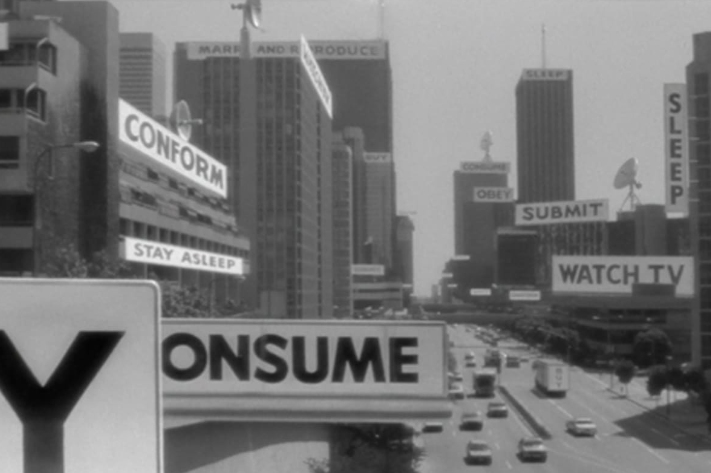
Deleuze and Guattari continue by referencing Marx’s analysis of the political economy:
Marx termed the twofold movement of the tendency to a falling rate of profit, and the increase in the absolute quantity of surplus value, the law of the counteracted tendency. (AO 34)
In simple terms, Marx’s law of the counteracted tendency, also known as the tendency of the rate of profit to fall, describes how the rate of profit in capitalist economies tends to decline over time. This happens because capitalists invest more in machinery (constant capital) relative to labor (variable capital). Earlier, we discussed Simondon’s concept of the technical machine. When a capitalist purchases a machine, it has a set market-value (constant capital) which is gradually transmitted to products that the machine produces. The reason the rate of profit falls as capitalists invest more in machinery is that profit comes from the exploitation of labor. Unlike machines, which have a fixed value, labor generates surplus value because workers are paid less than the value that they create. Essentially, workers produce more value than they are compensated for, and this difference is the profit for capitalists.
Let’s look at an example: A capitalist owns a factory that employs 100 workers. Does the capitalist like paying these 100 workers? Of course not! So, the capitalist buys a machine that can replace 50 of those workers, firing them in the process. However, even if the machine increases productivity by producing goods faster — it still has a fixed price. The machine can only transmit its value to the products it produces, but it cannot generate surplus value beyond its original cost.
Now, the capitalist has one machine and 50 remaining workers, but here’s the problem: the machine itself cannot create more profit. Therefore, the capitalist has to counteract the fall of profit: to generate surplus value, the capitalist must exploit labor. Perhaps the capitalist fires another 25 workers and forces the remaining workers to work twice as hard. Or, the capitalist might extend their hours, eliminate bathroom and lunch breaks, or cut wages. Does the capitalist like paying these workers $10 an hour? Of course not! So, the capitalist might fire the remaining 25 workers and rehire new ones at $7.25 an hour, knowing that there are plenty of unemployed people (100 of them fired from this job alone) eager to take those jobs.
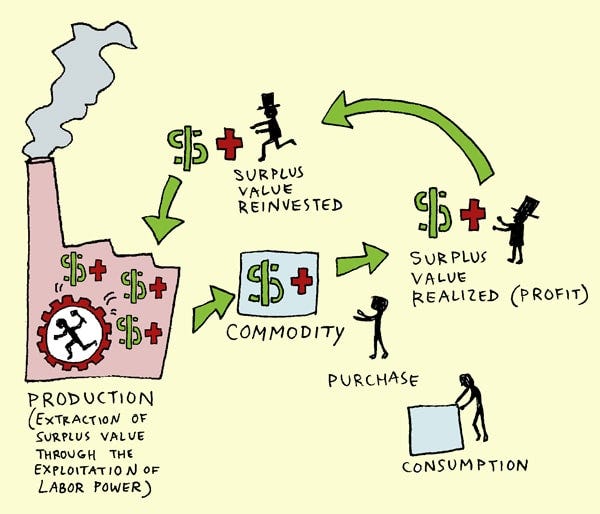
Deleuze and Guattari draw on Marx’s law of the counteracted tendency, arguing that decoding and recoding function within the same dual moment as the law of the counteracted tendency.
As a corollary of this law, there is the twofold movement of decoding or deterritorializing flows on the one hand, and their violent and artificial reterritorialization on the other. (AO, 34)
- Other examples of opposing forces preventing an extreme outcome would be supply and demand and inflation. For example, when we example supply and demand, it would make sense for companies to raise prices when the demand for a good or service is high; however, if the price is raised, that creates less of a demand. Or, to use another example, when inflation rises, workers may be forced to demand higher wages in order to keep up with the cost of living. In both of these situations, opposing forces operate, ironically, in tandem which prevents extreme outcomes in the system. Though this isn’t what Marx discusses with his law of the counteracted tendency, I find the parallel intriguing.
Finally, Deleuze and Guttari conclude this paragraph by describing the twofold process of the capitalist machine deterritorializing flows and reterritorializing flows:
The more the capitalist machine deterritorializes, decoding and axiomatizing flows in order to extract surplus value from them, the more its ancillary apparatuses, such as government bureaucracies and the forces of law and order, do their utmost to reterritorialize, absorbing in the process a larger and larger share of surplus value. (AO, 34–35)
This process was illustrated in the example above. Deterritorializing flows persist in extracting surplus value, while the limit of capital is established through the reterritorialization of these flows in the likes of bureaucratic legal institutions of “law and order.”
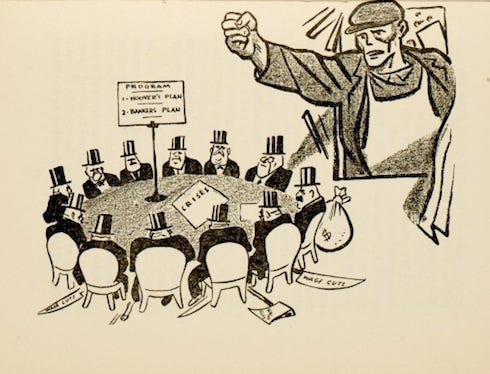
Paragraph Twenty-One
In the final paragraph of Chapter 1.4, Deleuze and Guattari highlight the role of the neurotic, the pervert, and the psychotic in contemporary society:
There is no doubt that at this point in history the neurotic, the pervert, and the psychotic cannot be adequately defined in terms of drives, for drives are simply the desiring-machines themselves. (AO, 35)
According to Freud and Lacan, the neurotic, the pervert, and the psychotic are understood in terms of drives, which Deleuze and Guattari view as purely desiring-machines. However, interpreting these figures solely through the lens of desiring-machines overlooks the territories they inhabit. Therefore:
They must be defined in terms of modern territorialities. (AO, 35)
Deleuze and Guattari begin by describing the territory of the neurotic:
The neurotic is trapped within the residual or artificial territorialities of our society, and reduces all of them (les rabat toutes) to Oedipus as the ultimate territoriality — as reconstructed in the analyst’s office and projected upon the full body of the psychoanalyst (yes, my boss is my father, and so is the Chief of State, and so are you, Doctor). (AO, 35)
The neurotic is ensnared by the artificial territorialities produced by society, reducing everything to Oedipus as the ultimate territoriality; they are projected onto the psychoanalyst’s entire being. In this way, the neurotic is confined to the roles society has imposed, with desire restricted, regulated, and channeled into these predefined structures.
And then, we encounter the pervert:
The pervert is someone who takes the artifice seriously and plays the game to the hilt: if you want them, you can have them — territorialities infinitely more artificial than the ones that society offers us, totally artificial new families, secret lunar societies. (AO, 35)
Unlike the neurotic, who passively becomes trapped within these roles, the pervert actively engages with the game, deriving pleasure from pushing these artificial territories to their extreme.
(Figure Eighty is the Lacanian conceptualization of the pervert and neurotic which will be further explained later).

Oddly enough, Deleuze and Guattari begin this paragraph by mentioning the neurotic, the pervert, and the psychotic, yet they don’t explain the territoriality of the psychotic here. Instead, they move on to speak of the schizo; however, it’s important to note that they do not equate the psychotic with the schizo (this distinction will be explored throughout Chapter 2). For now, we turn our attention to the schizo:
As for the schizo, continually wandering about, migrating here, there, and everywhere as best [the schizo] can, [the schizo] plunges further and further into the realm of deterritorialization, reaching the furthest limits of the decomposition of the socius on the surface of [their] own body without organs. (AO, 35)
Unlike the pervert, the schizo aims to completely reject and escape these artificial territorialities. The schizo roams the body without organs, striving to push beyond the limits imposed upon them and to create pure potentiality on their body without organs. The schizo is not bound to any single territory as they are constantly in a state of migration.
Deleuze and Guattari write of the schizo’s journey:
It may well be that these peregrinations are the schizo’s own particular way of rediscovering the earth. (AO, 35)
As stated in the earlier paragraphs, the schizophrenic seeks out the limit of capitalism:
The schizophrenic deliberately seeks out the very limit of capitalism: [the schizophrenic] is its inherent tendency brought to fulfillment, its surplus product, its proletariat, and its exterminating angel. [The schizophrenic] scrambles all the codes and is the transmitter of the decoded flows of desire. The real continues to flow. (AO, 35)
Here, it becomes clear that the schizophrenic plays a crucial role in the perpetuation and production of capitalism. By decoding flows, the schizophrenic “seeks out the very limit of capitalism,” thereby pushing the boundaries of capital further. This means that we should be weary of a common misreading of Deleuze and Guattari’s work. Deleuze and Guattari are not implying that schizophrenia is liberatory or revolutionary here. Now, they might be making an argument like that in Chapter Four, but that is not our focus; our focus in this Chapter is specifically a diagnostic one.
What must be noted here is that capitalism’s decoding of flows occurs through a schizophrenia as a process of production (with the transmitter of this decoding being the schizophrenic). Deleuze and Guattari mention the production of the real to highlight how, under capitalism, like any other socius, the real is produced in a tangible manner, specifically with the schizophrenic seeking out the very limit of capitalism. Deleuze and Guattari continue by describing the conjoined processes that make up the schizo:
In the schizo, the two aspects of process are conjoined: the metaphysical process that puts us in contact with the “demoniacal” element in nature or within the heart of the earth, and the historical process of social production that restores the autonomy of desiring-machines in relation to the deterritorialized social machine. (AO, 35)
Both of these processes appear to be emblematic of desiring-production and social production whereby the difference lies in terms of régime. The first process is concerned with a metaphysical process, concerned with eradicating the dichotomy between human and the “demoniacal” element in nature. The second process is concerned with homo historia whereby desiring-machines have autonomy and are unleashed from being regulated and channeled in a particular manner dependent upon the socius in which they are constituted.
Because Deleuze and Guattari have been discussing schizophrenia at length, they offer a clear and concise definition:
Schizophrenia is desiring-production as the limit of social production. (AO, 35; emphasis mine)
Therefore, Deleuze and Guattari appear to be answering the rhetorical question that they posited at the bottom of the eighteenth paragraph of this section with another question: Does capitalism produce schizophrenia or does schizophrenia produce capitalism? But why stop with this question? Might capitalism and schizophrenia be interdependently related? … Or, more precisely, is schizophrenia just the limit of any social production, to which capitalism has a unique relationship with because of its tendency towards this limit?
As previously mentioned, desiring-production and social production differ only in their regimes. So, how can we distinguish between schizophrenia and capitalism? Deleuze and Guattari explain that this distinction becomes clear at a specific point:
Desiring-production, and its difference in regime as compared to social production, are thus end points, not points of departure.
(AO, 35; emphasis mine)
Deleuze and Guattari argue that the difference in régime between desiring-production and social production cannot be understood by viewing them as separate starting points. Instead, it is at an “end point” that the distinction between the two becomes clear. Only when capitalism nears its ultimate limit — when it begins “breaking down” under its own contradictions — can we clearly distinguish between capitalism and schizophrenia. This is because only schizophrenia is capable of pushing the limit of capital further. Schizophrenia is a decoding and deterritorialization of the flows of desire that serves as a process of capitalism; however, these flows inevitably become contained through capitalism’s recording and reterritorialization which serves to maintain the limit of capital. Therefore, the distinction between these two forms of production is found at an endpoint.
We can finally conclude that capitalism and schizophrenia are interdependent, with one producing the other; and this produces reality:
Between the two there is nothing but an ongoing process of becoming that is the becoming of reality. (AO, 35)
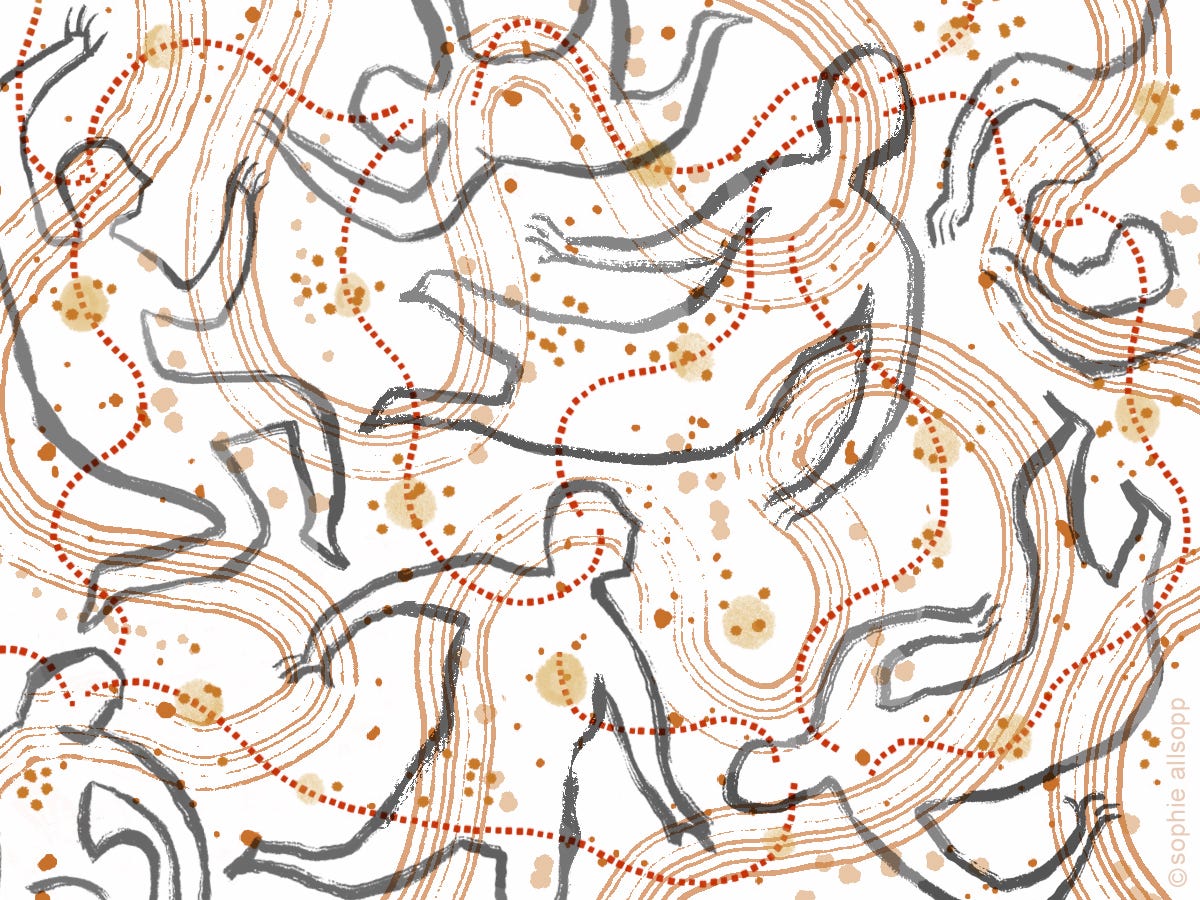
Deleuze and Guattari conclude Chapter 1.4 by emphasizing the importance of their materialist psychiatry:
And if materialist psychiatry may be defined as the psychiatry that introduces the concept of production into consideration of the problem of desire, it cannot avoid posing in eschatological terms the problem of the ultimate relationship between the analytic machine, the revolutionary machine, and desiring-machines. (AO, 35)
Deleuze and Guattari’s materialist psychiatry — if understood in terms of introducing the production process into the “problem of desire” — cannot avoid the technical questions pertaining to an ultimate transformation of desiring-production and social production: the revolutionary machine.
Quick Recap
Capitalism decodes flows of desire, constantly creating new possibilities to increase productivity and generate surplus value. This makes capitalism a highly creative and innovative system, continually pushing the limit of capital forward to sustain itself. However, if capitalism were to allow these decoded flows of desire — this schizophrenia — to have free rein, it would collapse, as capitalism needs boundaries to maintain its structure. To prevent this, capitalism must recode these flows, channeling desire back into socially productive forms (like the family, the state, and various artificial identities), thereby maintaining the limits of capital and ensuring its continued reproduction.
To put it simply, capitalism produces the schizophrenic subject because it requires schizophrenia as a way to resolve its own contradictions. Capitalism requires a creative force to continually generate surplus value amid its inherent contradictions. However, if left unchecked, the schizophrenic subject would no longer feel the need to conform to the artificial territory of capital — they would no longer adhere to the societal structures that sustain the system. Therefore, capitalism must recode these flows of desire, producing artificial identities that promote endless consumption within capitalism. These artificial identities, however, are simultaneously decoded by the schizo, who constantly pushes against the boundaries and constraints that capitalism seeks to enforces. This process of decoding and recoding happens in one fell swoop, akin to Marx’s law of counteracted tendency; allowing the system to move forward amidst its contradictions.
The implication of capitalism necessitating decoding and recoding means something very important: contradiction is built into the system.
— —
Citations:
- Deleuze, Gilles, and Félix Guattari. Anti-Oedipus: Capitalism and Schizophrenia. 1972. University of Minnesota Press, 1983.
- Freud, Sigmund. 1915. The Unconscious. PDF.
- Marx, Karl. Capital: A Critique of Political Economy, Volume I. 1867. Translated by Samuel Moore and Edward Aveling, edited by Friedrich Engels, Progress Publishers, 1887. Marxists Internet Archive, https://www.marxists.org
- Kant, Immanuel. 1790. Critique of the Power of Judgment. Cambridge University Press, 2000.
- Marx, Karl. 1844. Economic and Philosophic Manuscripts of 1844. (Critique of Hegel’s Philosophy in General).
- Pontalis, Jean-Baptiste and Laplanche, Jean. 1967. Vocabulaire de la Psychanalyse. Presses Universitaires de France, 1981.
- Pontalis, Jean-Baptiste and Laplanche, Jean. 1967. The Language of Psychoanalysis. Karnac Books, 1988.
- Nietzsche, Friedrich. 1883. Thus Spoke Zarathustra. Cambridge University Press, 2006.